Finally we can narrow down the date when our ancestor Domenic Troisi answered that help wanted ad for a job at Penn Garment Co. and moved to Williamsport, because he is listed in a Williamsport city directory dated January 1, 1914 — as “designer” boarding at 166 Mulberry. See it here:

]]>Article about Donatus Buongiorno published in academic journal
Day 16: Saturday, 3 November 2018.
Travel from Solofra, Avellino, Campania, to Caramanico Terme, Pescara, Abruzzo.
We got up early (for Carapelluccis), said goodbye to our wonderful hosts, snapped a few photos of them and their lovely property, also the view of Solofra from their hill (finally with no rain and decent light), then hit the road for our longest driving day, from one grandfather’s hometown to the other’s: Solofra, in Avellino, to Caramanico Terme, in Abruzzo—about 200 miles.

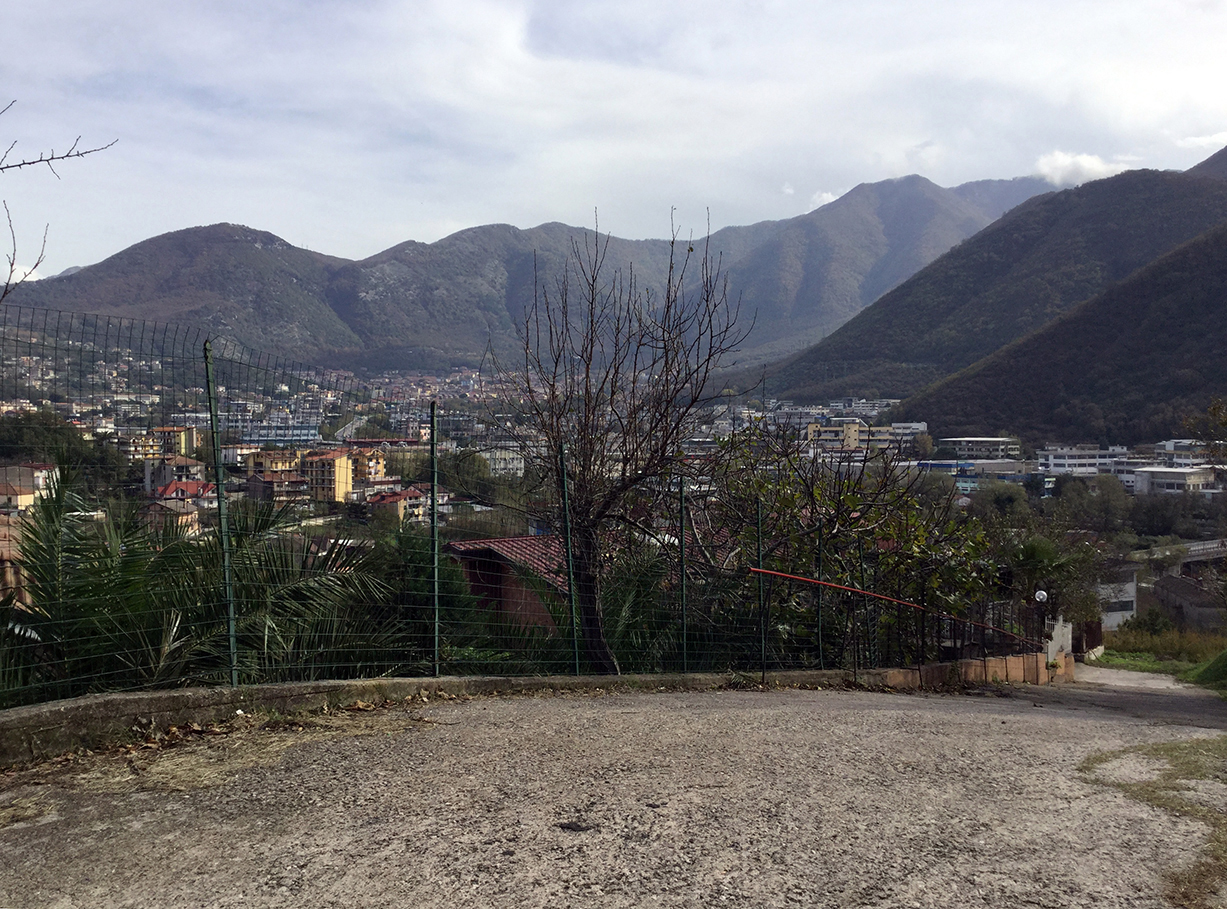
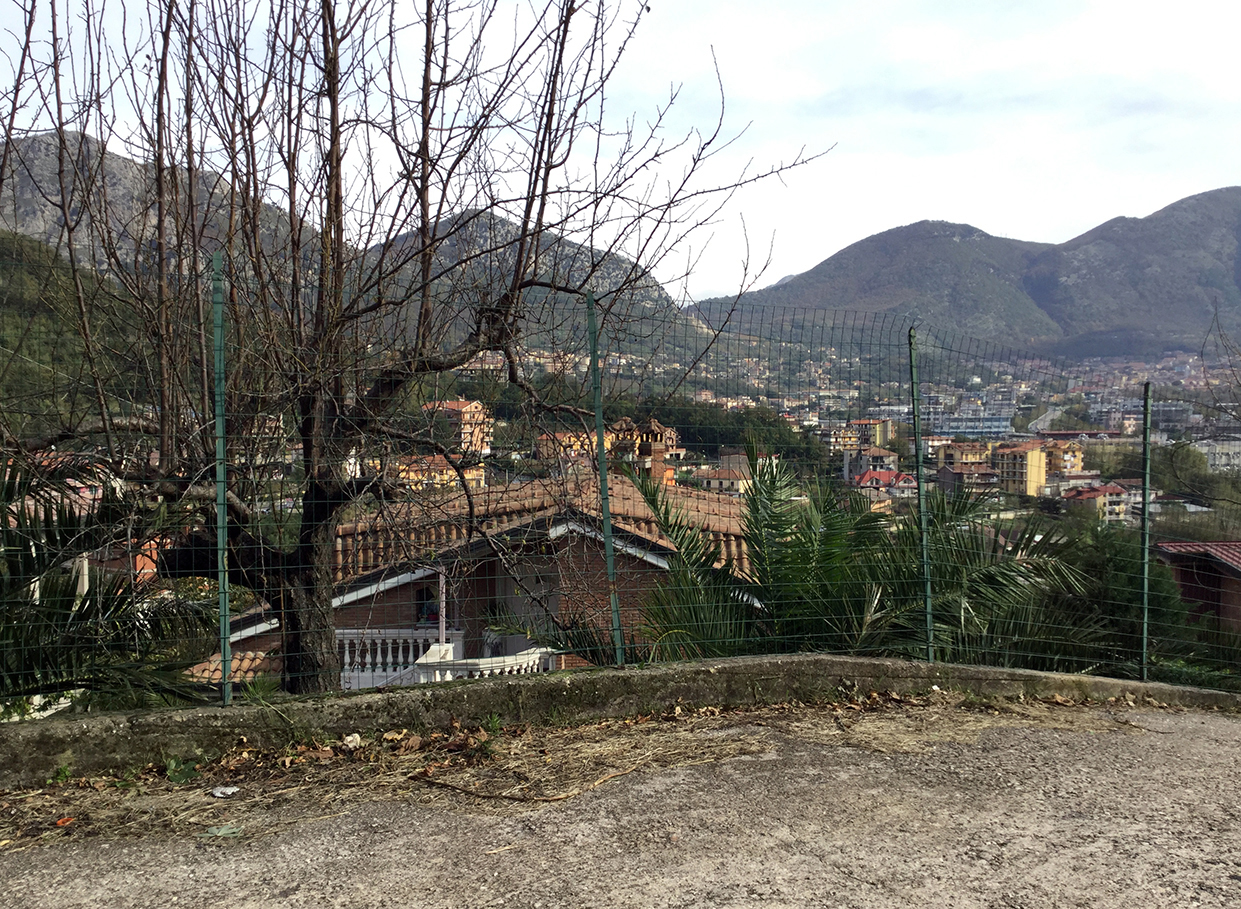
We had a nice day riding through the countryside of Campania, Benevento, a tiny bit of Molise, and Abruzzo.
Major shout-out of thanks to my fabulous brother-in-law Dave who did all the driving and my fabulous sister Loraine, who navigated using Google Earth on her phone. I got to sit in the back and just look out the window all day, like a princess with no responsibilities. (Princess Marg, for family members who know what that means.)
I made one contribution: a one-hour stop in the ancient ruins of the Roman city of Saepinum (Sepino), just outside Altilia. Read about it here.
A city on a former main road which Samnites, and later Romans, used to move their animals north and south seasonally, this place is totally off the beaten tourist path, and you can have it all to yourself. Park in the nearby restaurant and walk around, free admission.
It’s probably not a place worth searching out, unless you have a serious obsession with ancient cities. Not me! I’ve been spared at least one obsession, thank you, but if you ever find yourself on the north side of the mountains near Naples, do check it out for the rare experience of wandering a Roman site at will and not having other tourists mess up your photos.
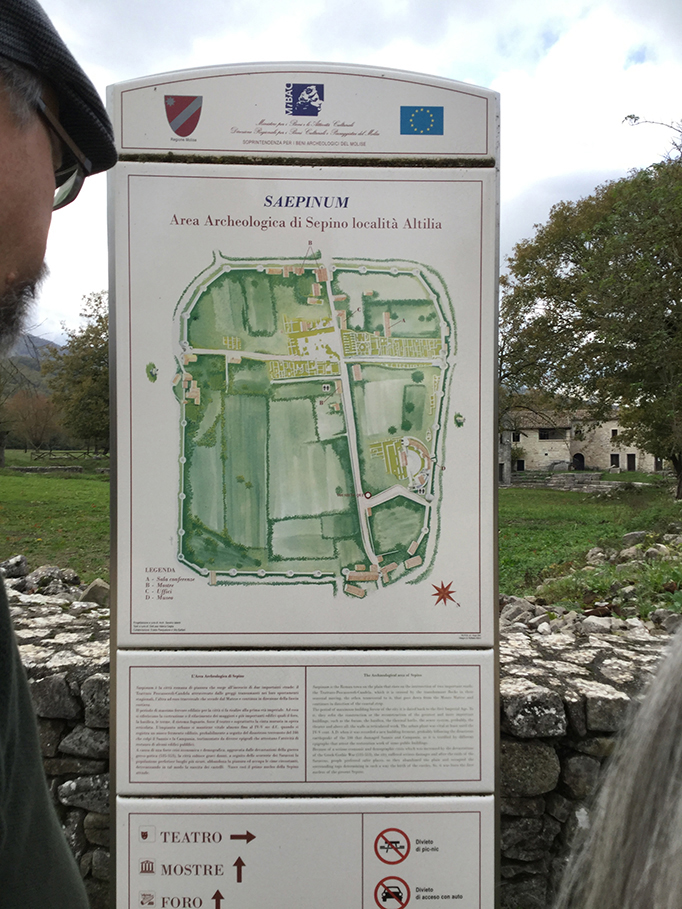

Click here to watch a contemporary performer on this ancient stage: Saep3
Being a graphic designer, I’m always a sucker for well-made Roman lettering. Pop quiz for anyone who’s been reading my posts from the beginning of the trip. What is the name of this font—it’s name now, having been known as “carved letters” at its inception, long before anyone knew anything about “fonts”?


Check out this “adaptive reuse” of a Roman plaque as the cornerstone of a medieval barn.
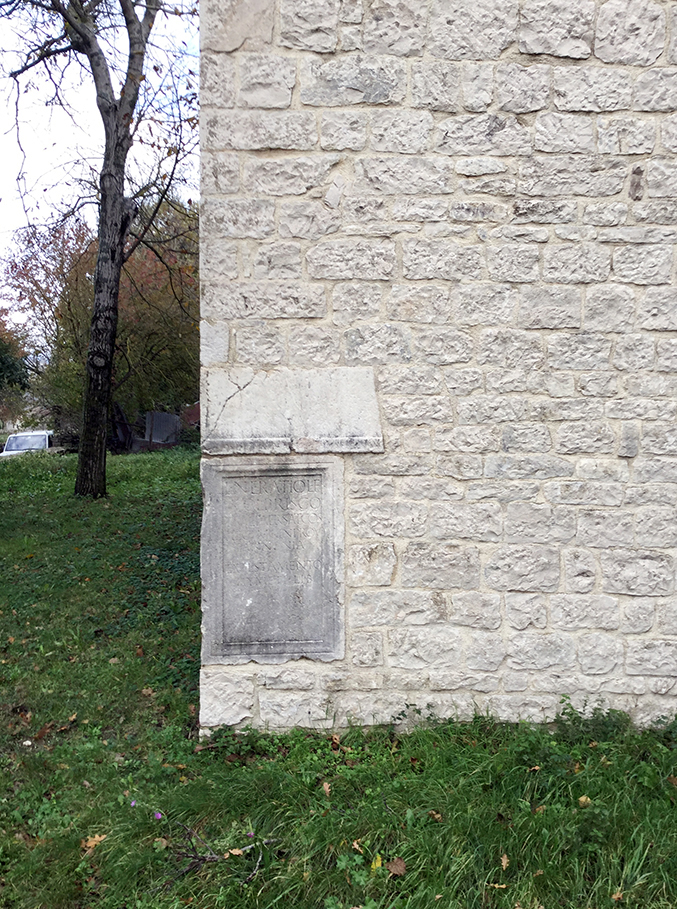

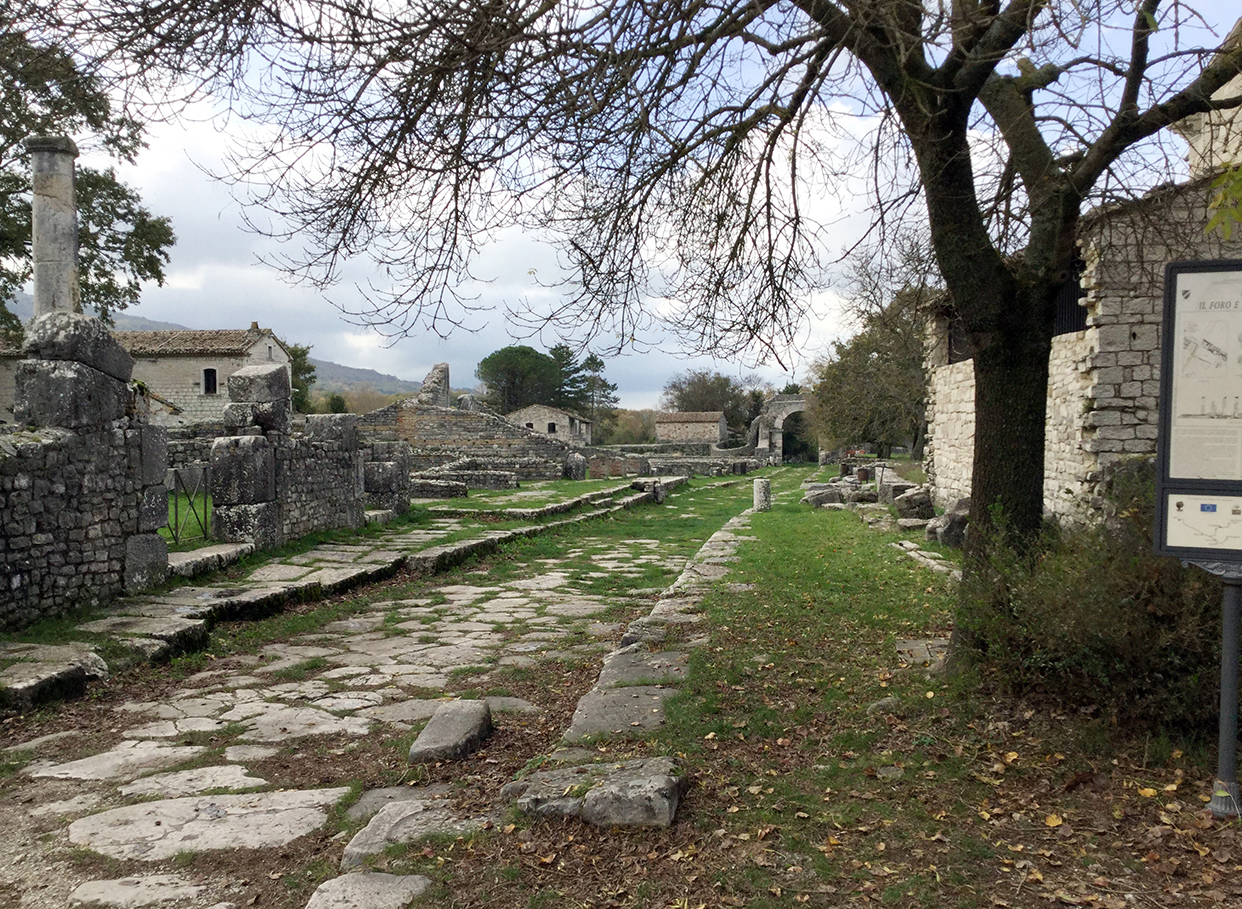
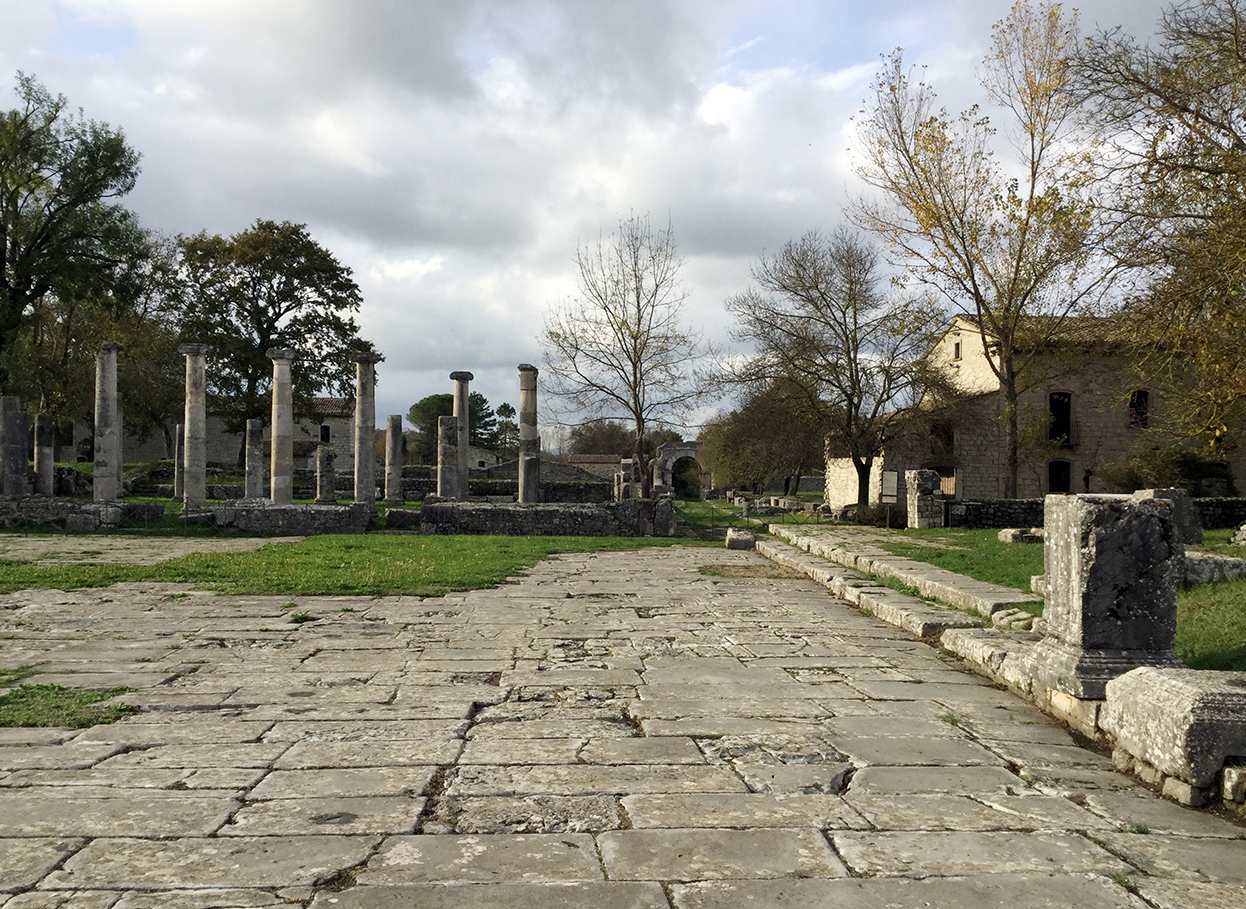
Back on the road, we see a lot of towns in the hills to both sides of the road. I expected back-county Italy to be poor and rundown. I’m pleased to report: not so. Though I only saw the towns from a moving car or at occasional rest stops on a highway, mind, I can report that there was farmed land everywhere (which was, presumably, thriving), every town had at least one or two factories (near the highway, plus maybe more elsewhere), and nowhere did the land or buildings look deserted, “untidy,” or rundown.
Plus, we saw multiple electric wind (mill) farms on the tops of ridges. At one point, we drove by a factory with parts out in the yard that I thought looked like airplane wings. Huh? Then it hit me: they were wind mill blades! So the mills were being made, and I guess assembled, mere miles from their sites!
I read later online that some people oppose the windmill installations for ruining their views of mountain ridges, but to us this is relative. In the U.S. we desecrate mountain tops with far more egregious strip-mining. I thought the windmills looked kind of cool.
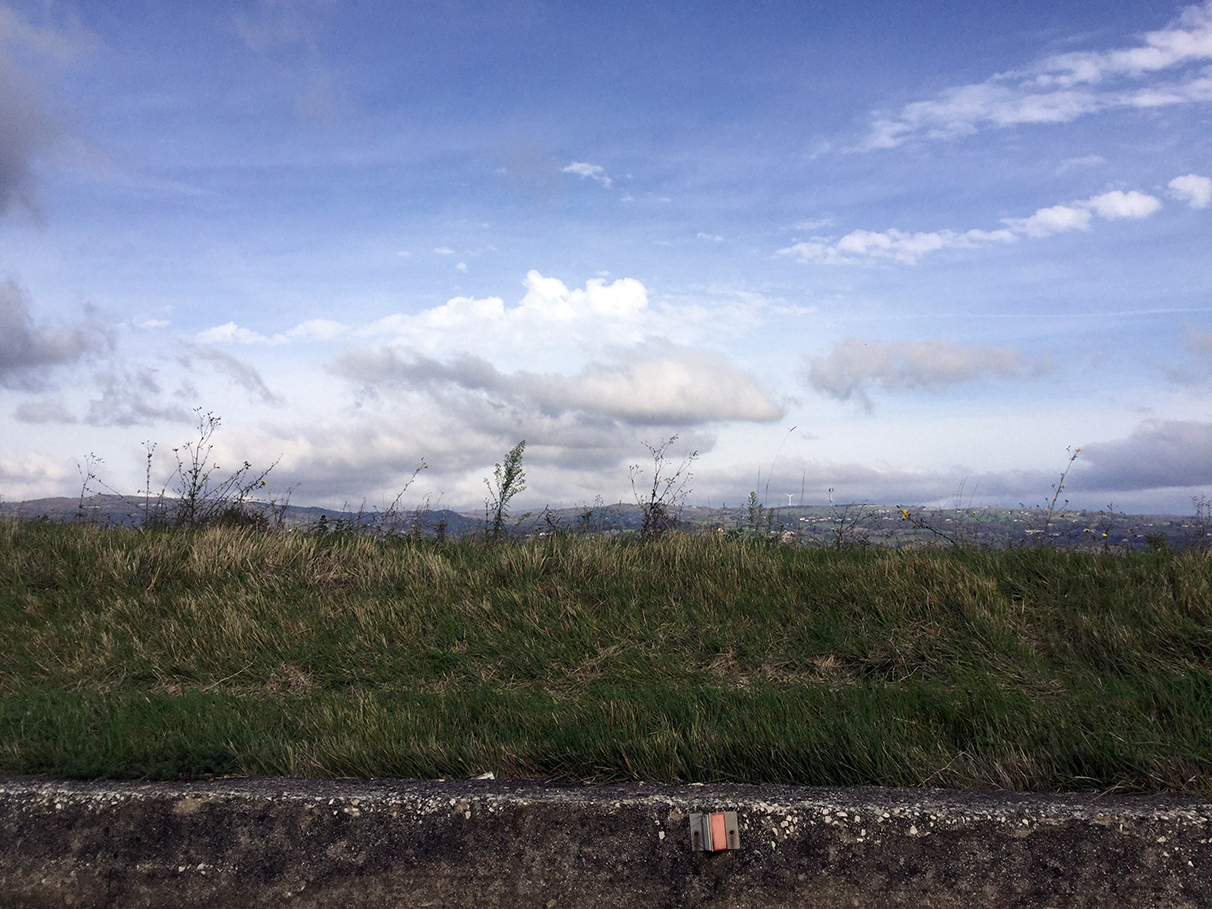
Also, the roads were well maintained, including in areas with serious winter weather, and there were numerous tunnels through mountains and bridges over high chasms.
Our drives were a lot faster than our ancestors’ trips in horse-drawn wagons when they left these towns in 1907, that’s for sure.
]]>
Day 15: Friday, 2 November 2018, morning.
Solofra, Avellino: All Souls’ Day, Giorno dei Morti (Day of the Dead)
Unexpectedly, we got another shot at meeting with Lucia Petrone, and my sister Loraine Carapellucci and I jumped on it. Without the translator this time, Loraine wielded Google Translate on her phone and Lucia used Google Translate on her computer. Between the two machines and my tiny bit of Italian vocabulary, somehow we communicated with each other.
First, Lucia showed us two books on the town’s history. Were they available to buy? No. No more in print, no extras in the office to sell.
So Loraine and I started photographing their pages, then Lucia interrupted us to tell us more information and to show us stuff on her computer. She would start to talk, then stop and type frantically on Google Translate instead. I loved the woman’s enthusiasm!
Loraine and I whipsawed between looking at Lucia’s computer, looking out the window at the church across the street, and photographing those unavailable books.
Lucia told us the story of the construction of the Collegiata di San Michele church, which astonished us.
The night before, we had learned from Alfonso Buongiorno how the tanning industry Solofra families started as conversos (former Jews) from Spain who migrated to Florence in the 1300s, which was the tanning center of Italy. At some point, they were invited by someone (a land baron) to move to Solofra to set up a competing industry.
Lucia explained that there had been an old church on the site of the Collegiata which the families deemed inadequate. In the early 1600s (which would be approximately 200 years after the converso families arrived in Solofra, so presumably the tanning business was profitable by then), they demolished the old church and built the Neapolitan Baroque building that exists today.
If we got the translating correct, Lucia told us the tanning families of the town pooled their money to build the church, and the chapels inside are named for them. They also hired the priest, who, besides directing spiritual life, functioned as the mayor (of sorts, this is before suffrage) and settled civil disputes. At one point, there was an argument over some matter and the priest defended the town instead of the government/crown. He was arrested, and the townspeople got him released.
“Collegiata”—collegiate—in the church’s name means it was also a school. There was a convent attached, and the nuns taught classes. Most astonishingly, girls attended as well as boys. Today, the school is, appropriately enough, the town’s public library.
And the church had one more role in town: bank. The founders of the church would deposit their money, and the church paid them interest. When they needed it, they could borrow it back, and then they would pay interest to the church.
This is an astonishing amount of power and autonomy centered in a non-governmental, non-royal institution. I’ve never heard of it anywhere in Italy, let alone in the south where the feudal system endured into the late 1800s. Has anyone else? Did we get the translating wrong?
When I told the story above to my friend Bill Russo in New York, I expressed it as, “They hired the priest, and he worked for them, not for the Vatican.” Bill blurted out, “That’s how a synagogue is organized!”
Is Solofra’s extraordinary history of progressiveness, self-reliance and agency a cultural legacy of its original families’ Jewish roots? Did the historic, formerly Jewish culture of this town create my ancestors’ can-do, optimistic personalities?
Looking out the window, Loraine remarked, “But what about the campanile (bell tower)? It looks different from the church.”

Lucia paused and placed her hand over her heart looking very pleased. Her reply: The campanile was built with the stones from the old church.
Loraine pointed out to me later that that question seemed to change the tenor of the whole afternoon. A switch flipped in Lucia’s head (and heart) regarding us: they get it. They care, and they are becoming involved in our history.
A few minutes later, when we were photographing the books again, Lucia came to the table, closed both books and pushed them across the table to us. “A gift. Please take.” We were speechless.
I hope she decided that those books were going to do more good for Solofra being on our desks in the U.S. than in a cabinet in her office, because Loraine and I aim to prove her right! We traded emails and plans to collaborate on future projects.
At one point, Mimma De Maio phoned in, so I finally got to talk to her in person and thank her for all of her work which I have been reading for years. She was my first “door” into the history of this town.
I suspect I am going to be involved with my grandfather’s family’s Italian hometown of Solofra, Avellino, for the rest of my life. And I am well pleased.
]]>Day 14: Thursday, 1 November 2018, afternoon.
Solofra, Avellino: Visit to Casa Buongiorno.
As promised, Alfonso Buongiorno arrived at our Agriturismo (with his brother-in-law, whom he enlisted to drive a second car) on Wednesday afternoon to take us (party of 6) to his home on a hill above Solofra. Alfonso, his brother, and his father Francesco own one of the tanning businesses in town, and they have new homes near each other in a “compound” that they built on the side of a hill above the old part of town.
When I walked in and saw 19th-century paintings on the walls, I knew I had found a soul mate. Alfonso said, “They aren’t expensive. I buy what I like.” I smiled and made a mental note for a future project: get Alfonso interested in hunting for Donatus Buongiorno paintings that are in Italy.
We met his wife Maria Giaquinto, who is an Izzo from Montoro Superiore, a nearby town. Remember New Yorker Bill Russo whose parents were both from Montoro Superiore? Bill’s mother was Anna Izzo. I felt the spirits starting to circle.
Bill actually found Alfonso for me. On Facebook, of all things. Much as I hate that site, I’m grateful it worked for this, because meeting Alfonso Buongiorno was a highlight of my trip to Italy.
Next we met Alfonso and Maria’s two teenaged children, Raffaella and Francesco, who couldn’t hide that they were a little annoyed that company arrived just as they were planning to go out with friends, and they were now expected to linger and be nice. (The ritual for the holiday, apparently, is that adults go to the cemetery and youngsters go to parties.) I didn’t catch all of the words, but I think the gist of the whispered conversation was “Daaaaaad….,” followed by “Just stay for a few minutes and be polite.”
Next Alfonso guided us to his office in a corner of the living room and on the wall was this beautiful artwork of his family tree. Holy moly.
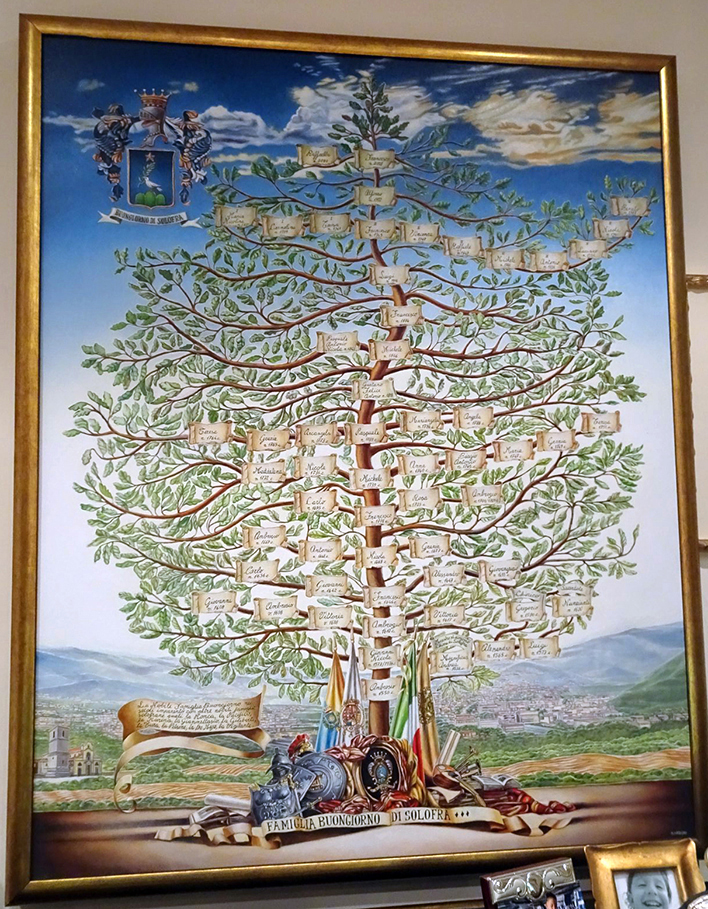
Then he pulled out a rolled up sheet with the family tree of “our” Buongiornos which I had emailed him before the trip (an org chart of boxes generated by a genealogy software program, with not-such-nice artwork). It was poster size. He ordered a digital printout somewhere.
(My work goes back to the 1850s and is based on vital records on microfilm I spent three years of Saturday afternoons reading at a Mormon Family History Center in Brooklyn. You’re welcome, Buongiornos and Troisis.)
Alfonso says, “I have figured out how we are connected. This Michele,” points to a leaf on his tree, “was a brother of this Biagio,” points to my chart, identifying two men who lived in the 1700s.
We are thrilled, and my cousins start snapping photos of all of us, of the “evidence,” etc. (Thank God they were there, because my brain was too overloaded to deal with a camera.)
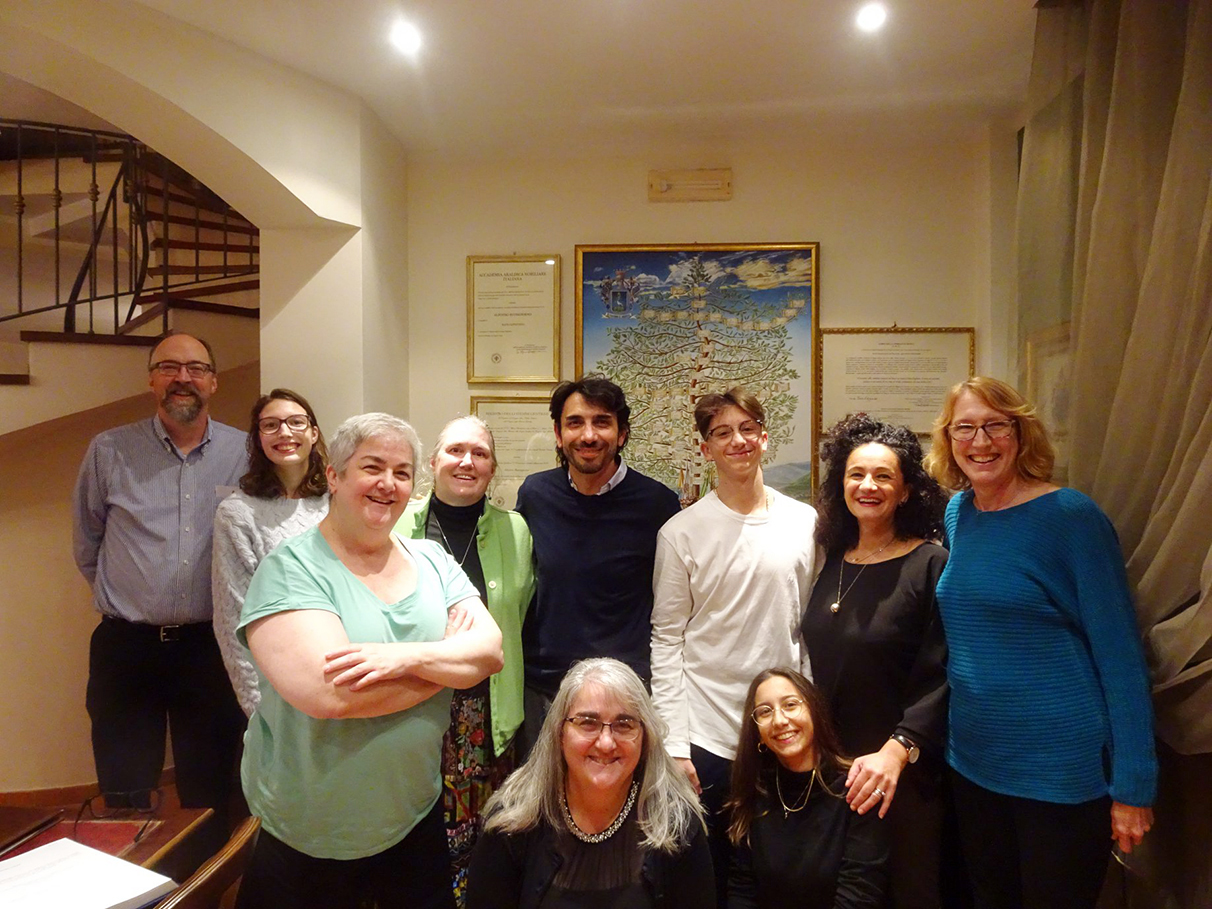
Then Alfonso pulled out the “report” that an Italian genealogist prepared for him of records going back to the 1300s: a 3-inch thick, bound book, on archival-quality paper, with pages that fold out and flip around, xeroxes of some documents, raised-seal (legally legitimate) copies of others.

My cousin Lisa said later, “I kind of blanked out there for a few seconds, because I can’t even conceive that anyone’s ancestry could be known back to the 1300s.”
Alfonso turned to a page he had marked in advance and said, “We are Jews. Conversos from Spain.”
He pointed to a line he had underlined. “The family name Buondiaz (Bonadies in Ladino) was translated to ‘Buongiorno’ in Italy.” (Spanish, Ladino and Italian, they all mean “good day”—which is used for “hello.”)
My family members’ jaws dropped; I smiled with pleasure. I had heard of this possibility before.
Years ago, an Italian art dealer told me that Buongiorno might be a Jewish name, explaining that “conversos”—Jews who converted to Catholicism in Spain during the Inquisition—were also forced to change their Jewish-sounding family names. They often “hid in plain sight” by choosing very common words from the local language for their new last names, such as “hello, goodbye, good day, good year.”
Alfonso explained that the family were tanners in Spain. When they left Spain in the 1300s, they went to the tanning center of Italy: Florence. After being there for a few hundred years, a Solofrano land owner (baron) offered them a deal—land for tanneries, plus favorable terms (probably in exchange for substantial taxes)—to move to this place in the south that had the necessary raw materials (goats, sheep, water) to set up a competing tanning industry.
They have been successful. Florence and Solofra together produce 60% of the leather that is used by the Italian fashion industry today.
Now I understand why Mimma De Maio—the Solofra historian who wrote solofrastorica.it—did her Ph.D. dissertation on the “medieval” tanning industry of Solofra. Because that’s when the industry started in this town; her paper is about the entire history of this defining industry of this southern town.
And now I really have to learn Italian, so I can read that paper, and more of her website.
Alfonso’s family are still tanners. He and his father and brother own a tannery in town.
At some point, “my” Buongiornos, the ones descended from 1700-something Michele’s brother Biagio, left tanning, and by the 1800s, were tailors, barbers, midwives and artists (which I know from my Mormon Family History Center research.) Why and how, I don’t know. As always with genealogy, answers to questions beget other questions.
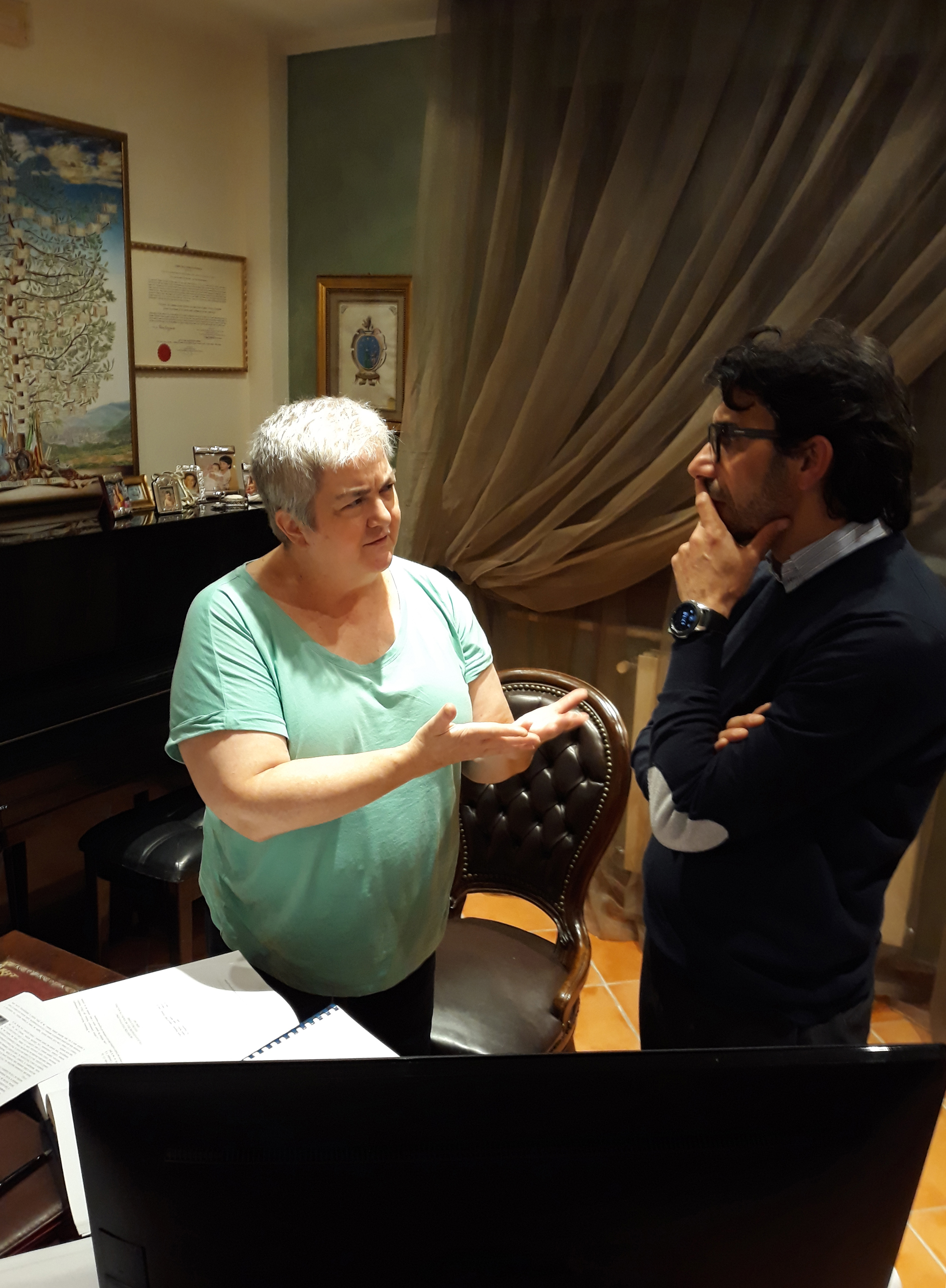
We are hours into our visit. Alfonso and I can go on about genealogy indefinitely, but our family members are ignoring us to eat snacks and talk about other subjects. Both teenagers are still in attendance, engaging with the American relatives they were sure would be bores.


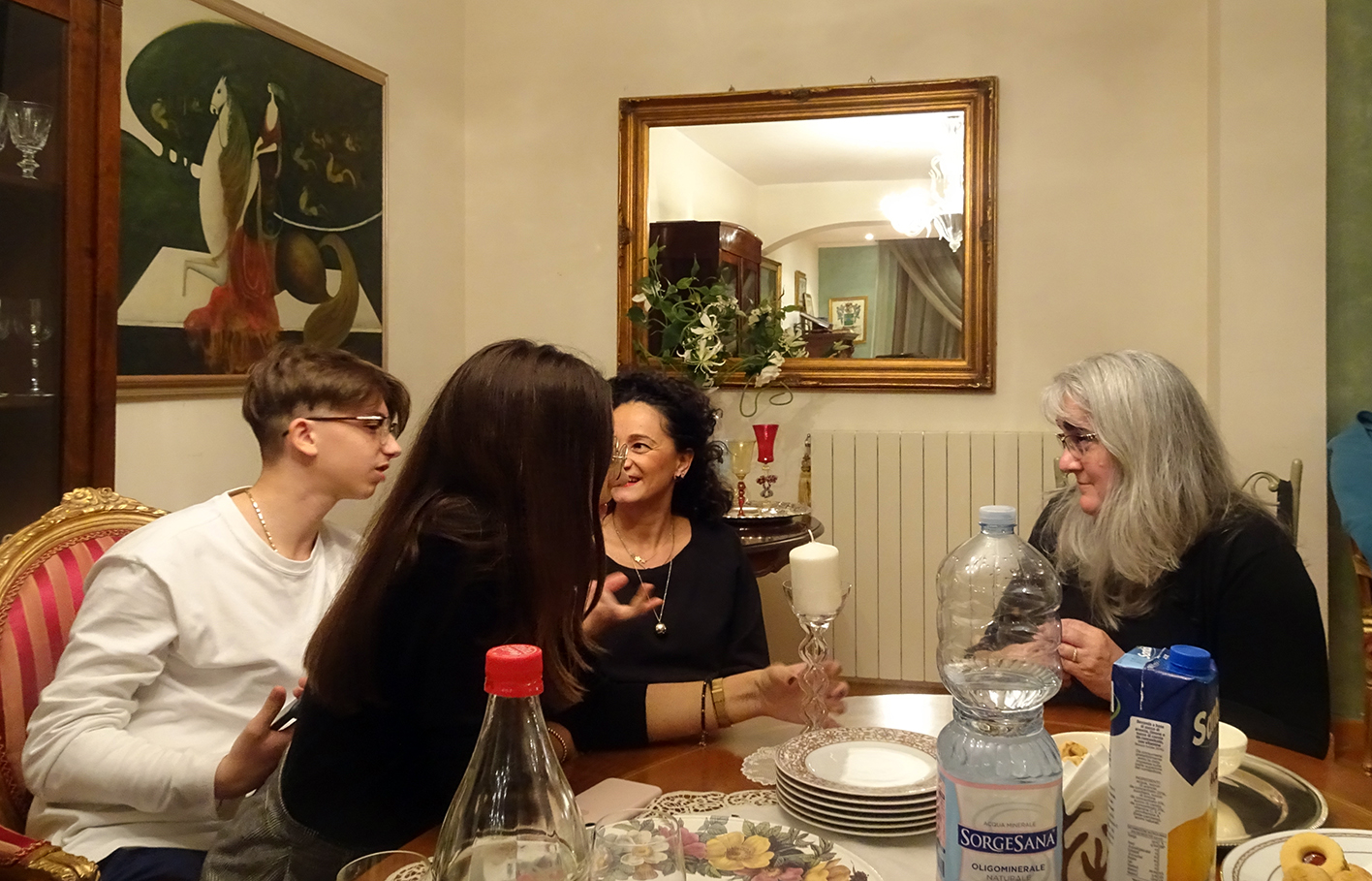
————————
I would like to pay back Alfonso for his hosting and overall wonderfulness by finding him leads for selling his leathers, and this is where you, dear readers, can help.
The tanning industry in Solofra took a serious hit with the 2008 worldwide economic downturn, and Chinese competition is edging in. Alfonso needs a customer who can not afford the time and interruption lost to bad deliveries or not receiving enough usable product to fill an order—someone who will pay a higher price to get reliable product on time. We are looking for a very high end fashion/luxury wholesale customer: a manufacturer who makes gloves, clothing, shoes, wallets, belts, etc.
Do any of my readers know of such a customer? I would not be involved other than to pass a name and phone number to Alfonso’s sales rep in New York. Please use my email or phone to contact me, both are visible all over my websites, and THANK YOU.
————————
Thanks to my sister, Loraine Carapellucci, my brother-in-law, Dave Handley, and my cousins, Julie Holm and Lisa Hamm-Greenawalt, who shot the photos in this post.
]]>Day 14: Thursday, 1 November 2018, morning.
Solofra, Avellino: Ognisanti—All Saint’s Day
We started the day with a breakfast visitor: distant cousin Alfonso Buongiorno. He told us a little history of his family as tanners in the town and asked, “Would we like to visit his home later in the afternoon to see his family tree and talk more?”

“Hell yes, we’ll be there,” I was thinking, but I held back and pretended to wait for my family members to discuss it and come to a group decision. Arrangements were made and he left.
Then we trooped into town to attend the holiday mass in our family’s church. Feminists all, we were favorably impressed that the pastor, Father Mario, made it as progressive as he possibly could within the “rules” of a Catholic mass. Women parishioners helped served communion, and young girls did a reading.
After mass, we followed the crowd to the nearby cemetery, as visiting the dead is what you do on All Soul’s Day. It was down a hill about a mile away.
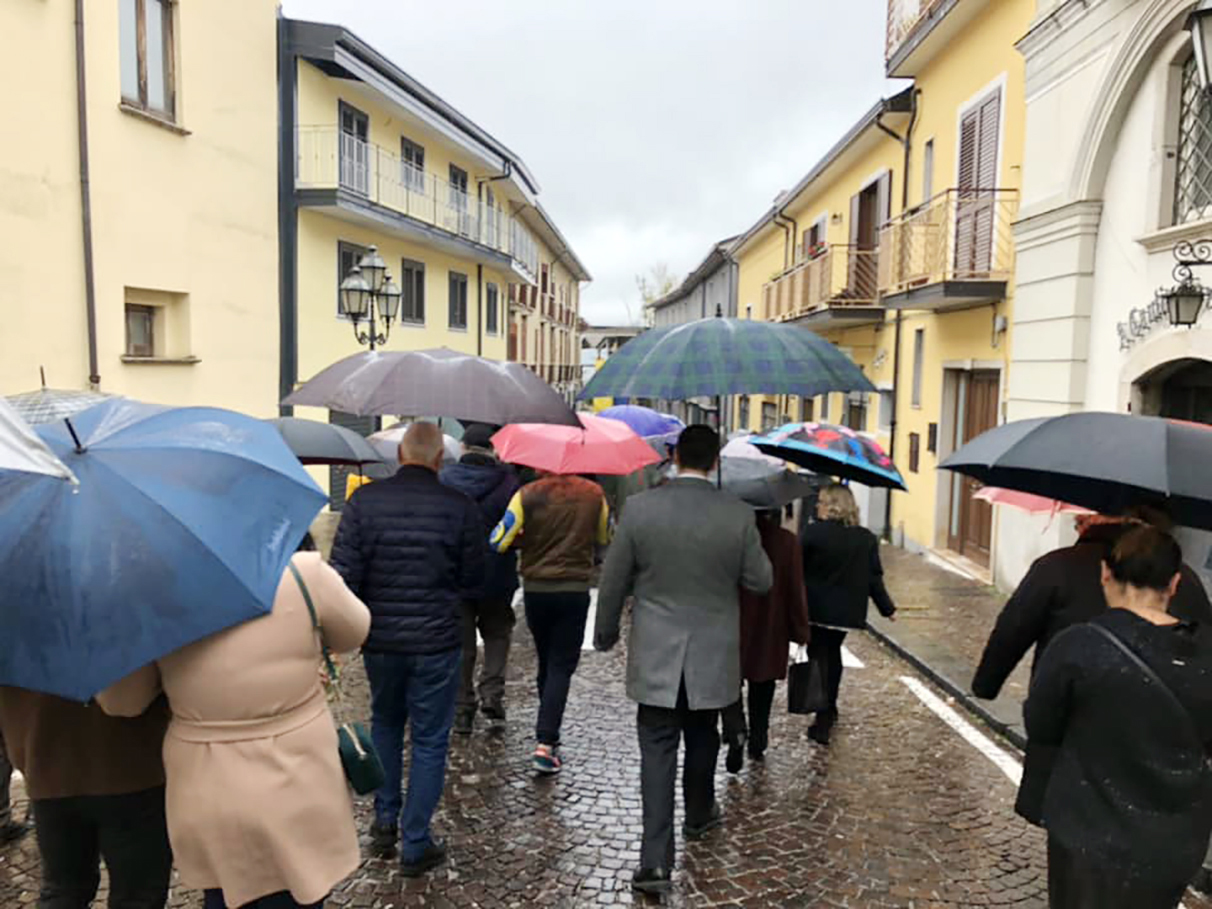
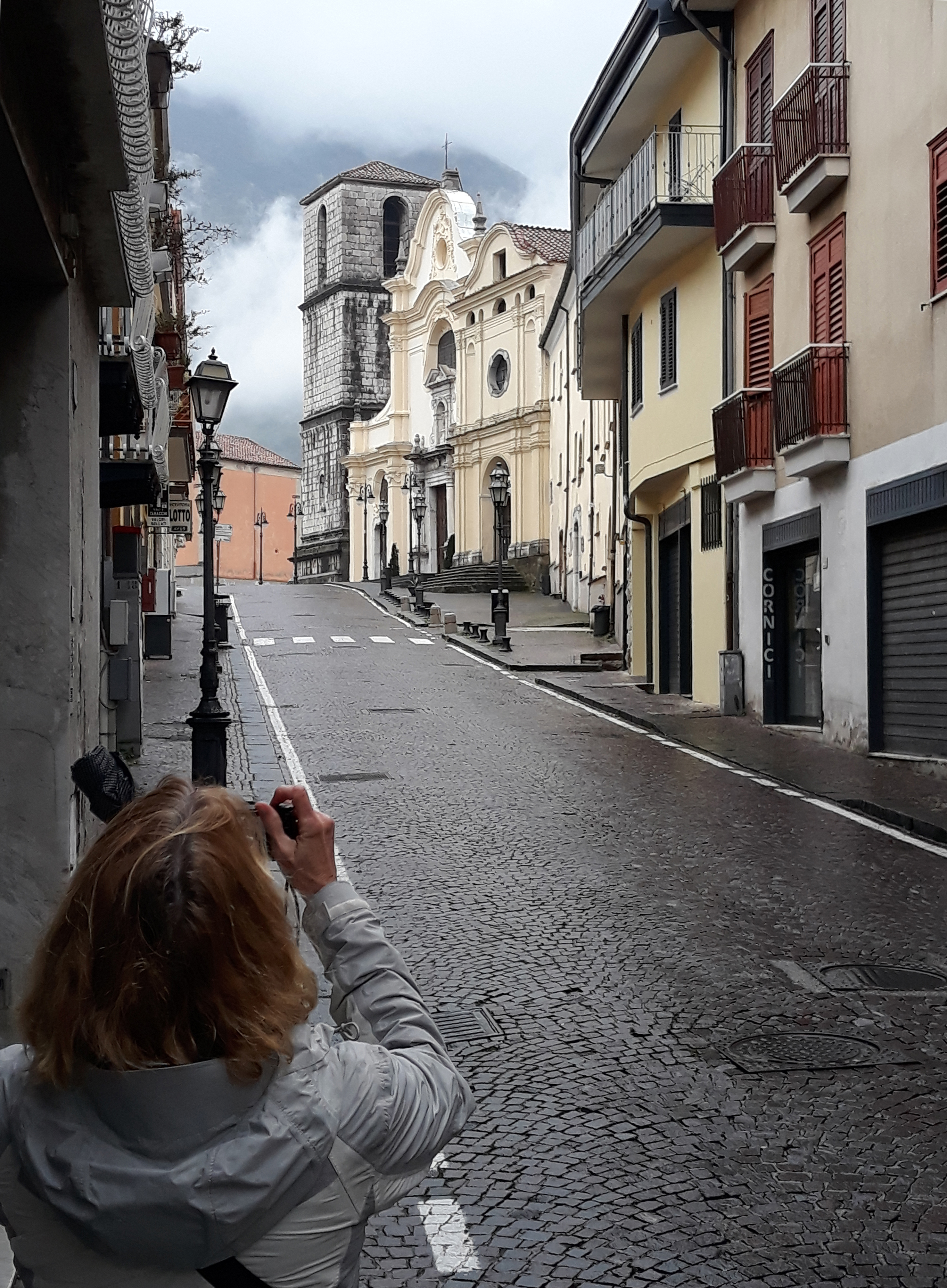
I walked with my sister Loraine for a while. She spied a broken-down chapel and asked if I wanted pictures of it. “Yes, thank you.” I didn’t tell her that it was one of the 5 or 10 “historic” buildings in town I had spied (and marked on a map) while “walking around” via Google Earth 10 years ago—checked that box. (By this point, I was keeping mum about some of my “planning lists,” as my family members were already worrying that I was a bit “around the bend” with my agenda for this trip.)

It was hard to imagine what Solofra looked like when our family lived there in the 1800s, because the 1980 Irpinia earthquake hit this town hard. Some buildings, like this chapel, were left as ruins, while others were rebuilt with new finishes (covered with a thick coat of cement-like material which ruins their historic appearance) or are completely new..
I’m a pokey walker and was lagging behind my family after 10 minutes or so, when…I got a ride! I spied an elderly man I had met the night before (in the church) in a car, waved like a maniac, knocked on the window, and he said, “Sure jump in and get a ride from my son-in-law” (the driver.) I pretended to chat and understand what the three of them were saying in Italian while cruising down the hill to where I met my family members who hadn’t even realized I was missing.
My sister Loraine got pulled out of the route by a local elderly woman who wanted to show Loraine her church, which was along the way. So Loraine went in and dutifully walked around for a few minutes.
Loraine and I found this happened routinely in both of our grandfathers’ small towns which we visited. People were interested in us and proud of their town and wanted to show us things. They also routinely didn’t care that we didn’t understand their non-stop Italian chatter.
The cemetery was interesting. There were lots of tombstones with photos on them and lots of mausoleums with family names on them, including names that we recognized, but we learned that none of them were going to be relevant to us: too new. We were told that graves (in most of Italy and much of Europe, apparently) are re-used after 50 or so years, that the bones that are dug up and put in common ossuaries without specific records of who is in them.
In all the years I’ve spent preparing for this trip, and in the flurry of emails during the last month before I left the U.S., someone couldn’t have told me this crucial detail?
Our ancestors left Solofra in the late 1800s and died in other places—Naples or the U.S. The graves of any family members before them who had been buried in Solofra had been recycled years ago, so we were not going to know anyone in this cemetery.
That kind of killed our interest, but I took a few photos of the more flamboyant tombs anyway, including this Egyptian style monument which can even be seen from the road outside the cemetery (Google Earth photo inserted because I can’t find my own shot), and this grave of a Russo that has a photo (of the dead guy), for my friend Bill Russo of New York, in case they are related, as his family is from Montoro Superiore, a town that is only a mile away from Solofra.
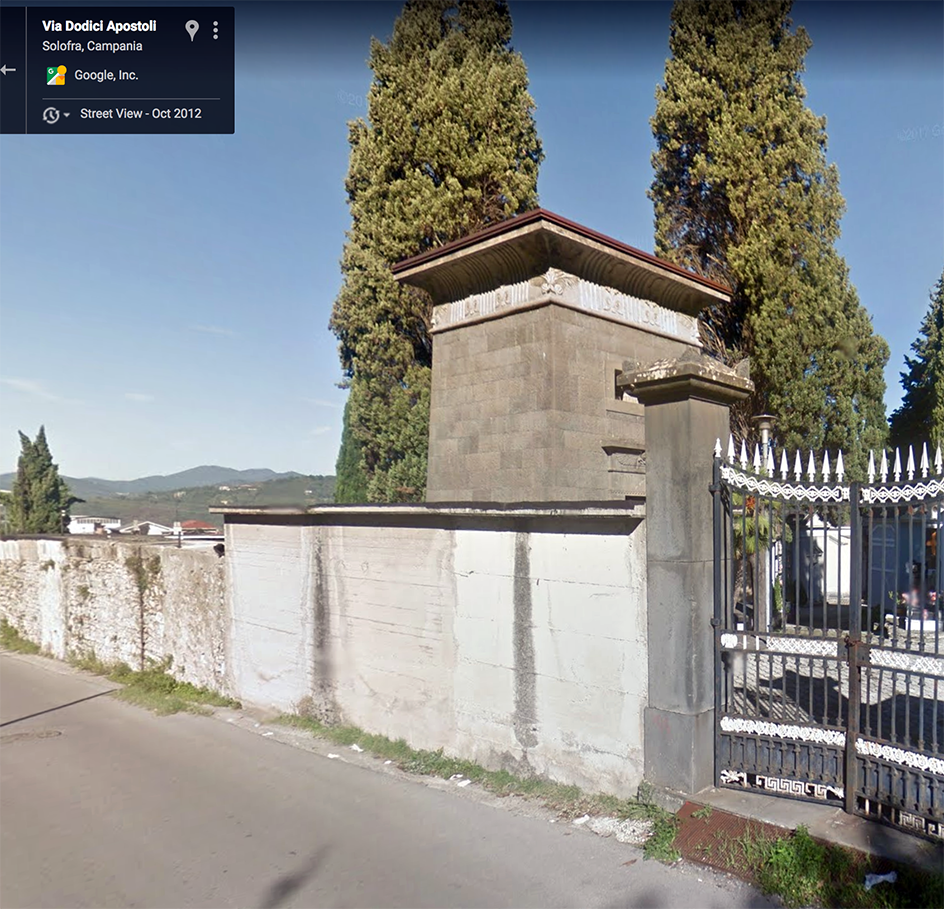
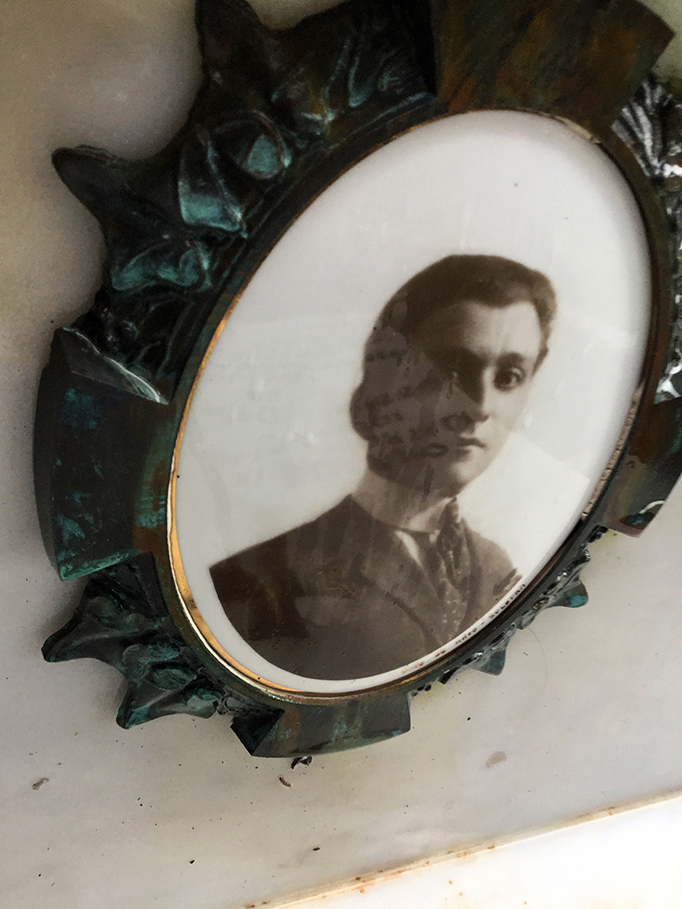

So the cemetery part of the “genealogy experience” of this trip was a bust. But it helped Loraine and I refine our plans for the second, small town we were going to visit. When we went to our other Italian grandfather’s home town the following week (in Abruzzo), we skipped its cemeteries.
We left the Solofra cemetery and went back up the hill for lunch in the main part of town. Then we went back to the Agriturismo to clean up (it had rained all day) for our visit to Alfonso Buongiorno’s house.
Thanks to my sister Loraine Carapellucci, and to cousins Julie Holm and Lisa Hamm-Greenawalt who shot many of the photos in this post.
]]>Day 13: Wednesday, 31 Ottobre 2018.
Travel from Napoli, Campania, to Solofra, Avellino.
Busy day.
We got up early, hustled to the train station, hustled to figure out how to buy the correct train tickets in a vending machine that was in Italian, figured out whose internationally registered credit card to use so it wouldn’t get rejected for being foreign (Julie’s), and hustled to get on the correct train. The one-hour ride to Salerno was pleasant and uneventful. It was a brand new train on brand new tracks.
We hiked through the Salerno station and crossed the street to a rental car place which was reasonably efficient (for Italians) at producing a car in under an hour. Then we wormed our way through local streets to get out of town and headed north on a highway. My sister Loraine was the navigator looking at Google maps or something on her phone and telling her husband Dave, the driver, directions, where to turn, how far to go until the next decision point, etc. It worked splendidly.
In Solofra, we went directly to the Collegiata church, figured out where to park, met our hired guide, Giuseppe Guanci, and got to the city hall by noon for our appointment with Lucia Petrone.
Big breath of relief.
Lucia is lovely and gracious—and speaks machine-gun-fire Italian. Giuseppe can hardly keep up, and when he’s translating to English for us, she interrupts him to tell him even more information in Italian. We hear about the city hall (former palace of Orsini family feudal land owners) and the Collegiata church (La Collegiata di San Michele Arcangelo), all of which I already knew.
It was the afternoon before a 4-day holiday weekend. Lucia had promised us two hours, and I think she was feeling the pressure, as much as we were, to pack those two hours with information.
Me: What about Donatus/Donato Buongiorno? He worked on a restoration of the Collegiata in 1908…?
Don’t know anything about that, but if you want to provide a (mural-size) copy of one of his paintings, we will frame it and hang it in our fancy meeting room here at city hall with the Guarini paintings (reproductions) we already have on display.
Not shabby company for Buongiorno, I think to myself, and make a mental note to follow up on this.
Lucia insists she must show us the church, so we go downstairs, cross the street, and go inside. In one of the big side chapels, Lucia tells us why the painting by Guarini is important: because the figure’s feet are dirty. Because that is proof that Giovan Tommaso Guarini, the Solofra-born artist of many of the paintings in the church (including the stunning scenes on the ceiling), did study with Caravaggio (in Naples)—because Caravaggio famously painted figures in religious paintings with dirty feet. (Caravaggio was an early modernist who re-introduced naturalistic details to reverent scenes.)
Then Lucia took us next door to the former convent and school, part of which is now the town’s public library. A few specific books had been pulled to show us. The librarians, or some other people, were hovering nearby, waiting for us to finish, no doubt, so they could leave early on the holiday evening. Lucia had those people make xeroxes for us. Julie shot photos, Giuseppe continued to try desperately to keep up with Lucia’s talking, and the members of our party surreptitiously took turns slipping out to use the library’s bathroom.
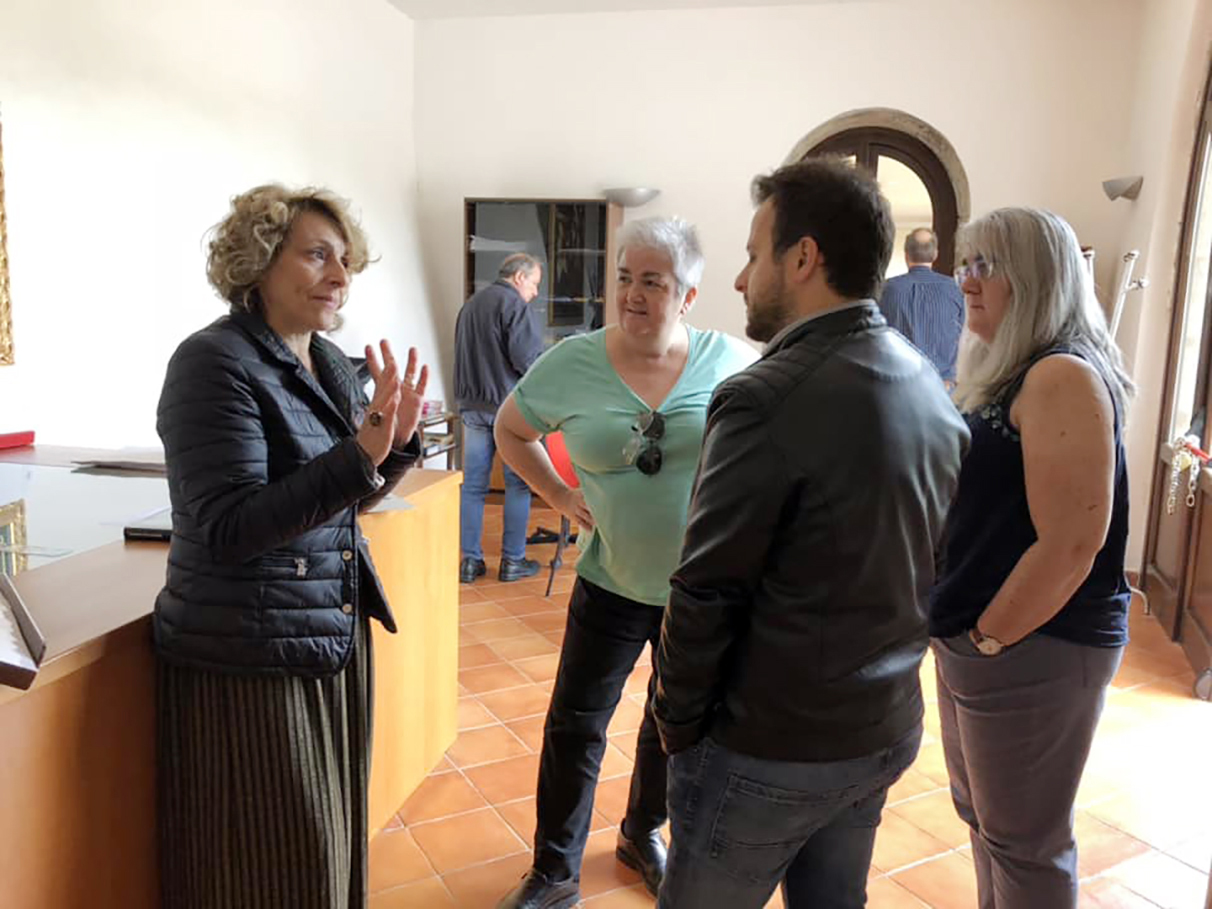
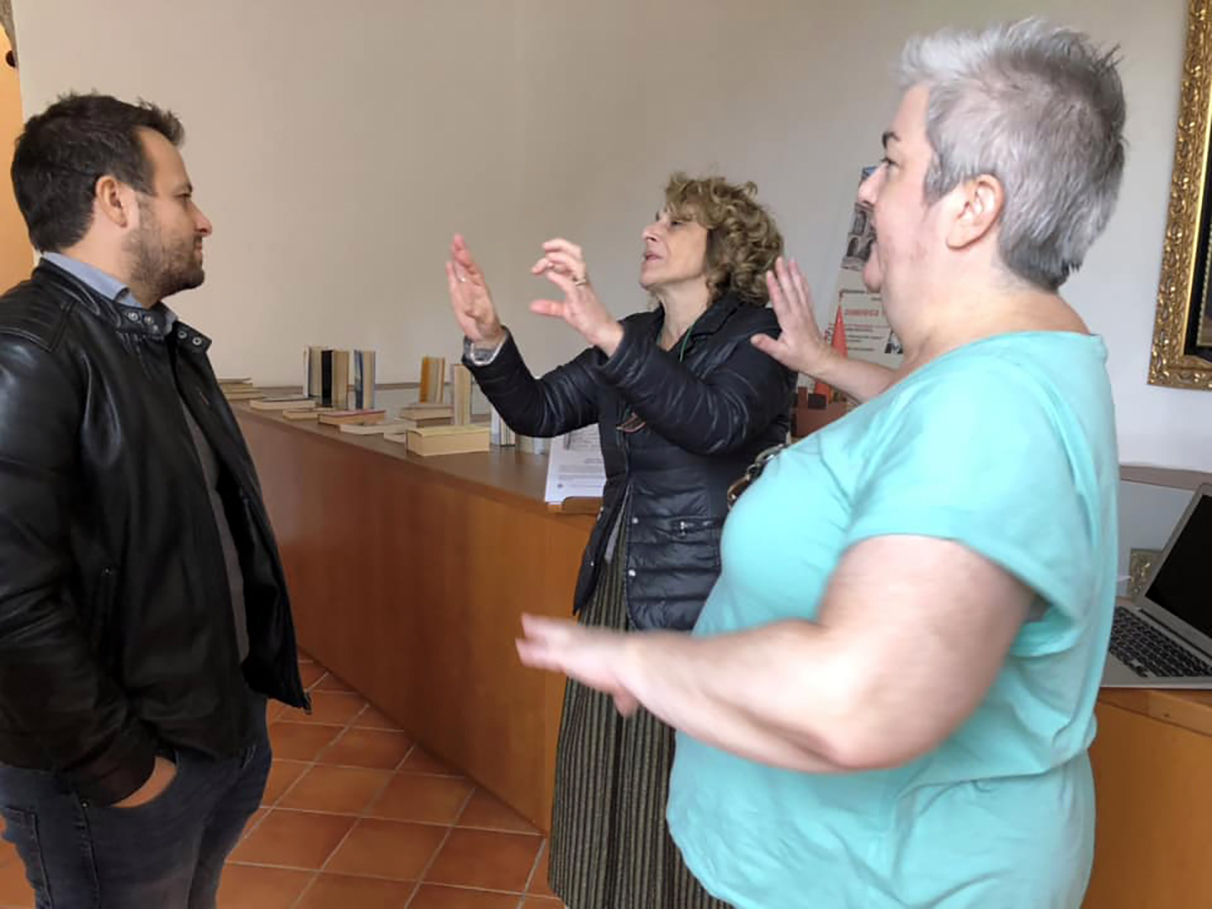
What a head full. I was exhausted trying to keep up with her, and frustrated that she didn’t know anything about the topics I am interested in: Donatus Buongiorno’s career, our family’s tenure in Solofra, etc.
She had to leave at 2 pm. We went back out front. We asked for a recommendation of a restaurant for lunch, and she pointed to La Taverna del Principe across the piazza.
We said goodbye and walked to the restaurant. I invited Giuseppe to join us. What a gold mine. Not only did it give him another two hours to translate for us, but he’s a gourmand who also narrated about the food—of which he approved. He told us that he’s no longer working as a genealogist, actually, but now runs gastronomy tours of the five provinces of Campania—Napoli, Caserta, Avellino, Benevento and Salerno. We let him order for us and choose all the wines.

If you are ready for a gastronomy tour of Italy that your friends who have been to Umbria and Tuscany can only dream about, give this man a call:
Giuseppe G.
Consulente di Viaggi | Aj54
Agenzia di Viaggi /Travel Agency | Aj54, very Authentic Journeys | Via Manfredi, 54 – 83042 Atripalda (Av) | Italy
Tel./Fax. +39 0825 460358 | M. +39 340 3137039
[email protected] | www.aj54.it
After lunch, he walked us to the best dessert place in town—Caffé Vignola—then said goodbye.
The night before, he had sent me some items he photographed at the Avellino library for me. Not until I was back in New York did I look at them and see that they are the 1911 articles about Buongiorno from Le Rane, a vintage local newspaper, which Mimma De Maio, town historian, cites on her site. Yeah!
We sat for coffee and pastries and tried to catch our breath.
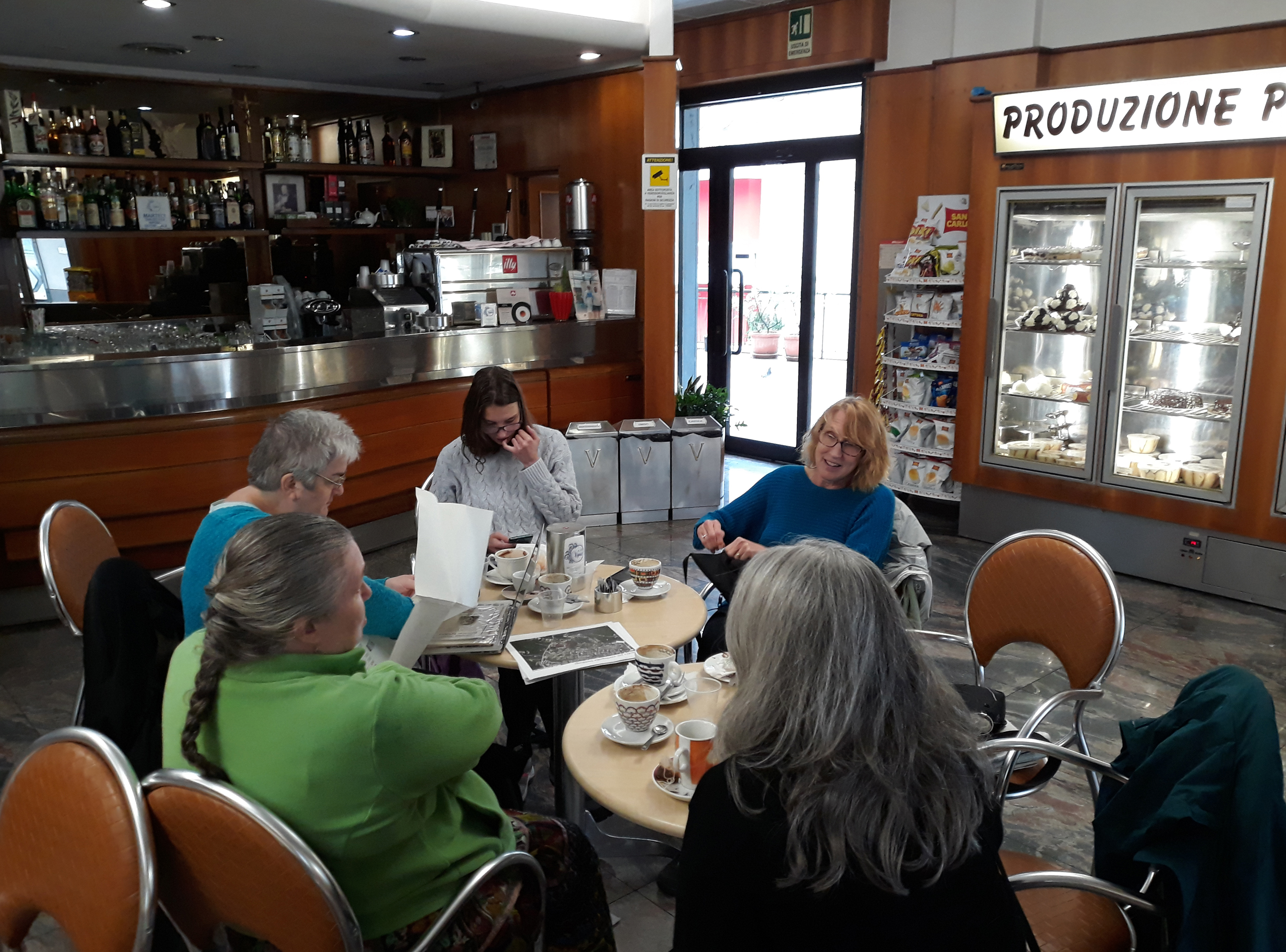
Then we went back to the church to explore at a more leisurely pace. We chatted with “Don Mario” (Monsignor Mario Pierro), the pastor, and met some old men who seem to spend their days hanging around the church. (Curiously, the hang-arounders in New York City Italian Catholic churches are usually elderly women.)
We explained who we were, and, like Lucia, they shrugged at my story of Donatus Buongiorno restoring paintings in the church in 1908, but as soon as they heard “Canonico Troisi,” the flood gates opened. Canon Carmine Troisi, 1866-1948, pastor of the collegiate church for 50 years, was my great-grandfather’s brother. There’s a plaque with the priest’s name on the front of the church, and everyone in town knows who he was.

A few of the men took us into the sacristy to see its paintings (and a glass ossuary holding someone else’s bones including a skull, which was totally gross), and another room where Carmine Troisi’s bones are buried in an ossuary under the floor which has a carved, marble, plaque-like cover. He’s buried with other priests, too, we think—the translating was getting a bit shaky by this point. Then they showed us the farthest-back room, which looked like a school room, which they explained is where Troisi actually died. He had a heart attack or something during catechism class, apparently.
Whew.
So we visited great-grandpa’s brother the priest thoroughly. The priest for whom our great-grandmother, Maria Michela Buongiorno, Donatus Buongiorno’s sister, worked as a housekeeper before marriage, which is how she met great-grandfather Beniamino Troisi. They were married in this church in 1877. Have I adequately explained why we needed to visit this town?
Done with downtown Solofra for the day, we drove up the hill on the north side of town to the Terranova Agriturismo Solofra to check in. Cousins Lisa and Lexie were already there, having come directly from Naples separately from us. Our hosts, Maria Buonanno and her father Norberto Buonanno, are lovely. Later in the evening, Maria cooked us dinner and shot this group photo. (Signor Buonanno is at the table in the back on the left.)
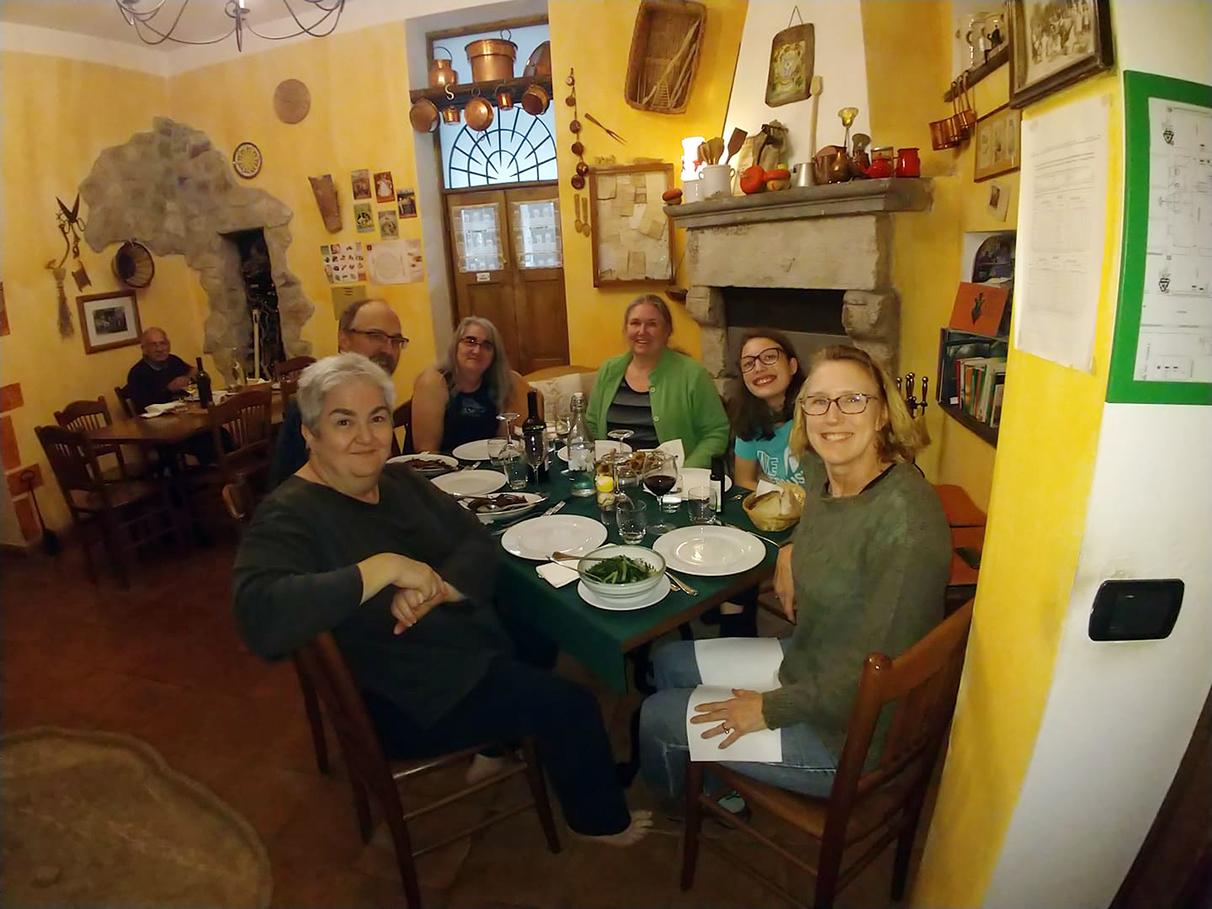
Day 12: Tuesday, 30 Ottobre 2018.
Napoli, Campania: Accademia di Belle Arti di Napoli.
My efforts to find out more about ancestor painter Donatus Buongiorno in Naples were thwarted at many turns, including his alma mater, the Accademia di Belle Arti di Napoli (Academy of Fine Arts of Naples.)
After a few false starts, and iffy leads to uninterested people, I finally hit pay dirt when my New York paintings conservator Luca Bonetti asked a conservator friend in Rome (Antonio Iaccarino Idelson, who doesn’t know me but thank you, Antonio!), who provided the name of Luciana Festa, who teaches stone (sculpture) conservation at the school.
See her talking about a recent project restoring Syrian sculptures here.
Luciana was the BEST. She talked to the school’s archivist and others before I arrived (a rarity among Italians, I’ve learned, who generally didn’t do anything until I was standing in front of them), and she sent answers to many of my questions in advance, which helped me plan the best use of my time on the ground.
We met for lunch and she provided the depressing explanation of why the school has no records of Donatus Buongiorno’s tenure in the 1800s: big fire after WWII bombardment by Allied forces burned up their archives. Mea culpa, mi dispiace. Not for the first time in Naples, I found myself apologizing for the actions of my army in the 1940s.
So I will provide the records “back to them!” I plan to submit a report of my ancestor’s career for their re-constructed archives.
Here’s the obligatory, blurry selfie of the two of us.
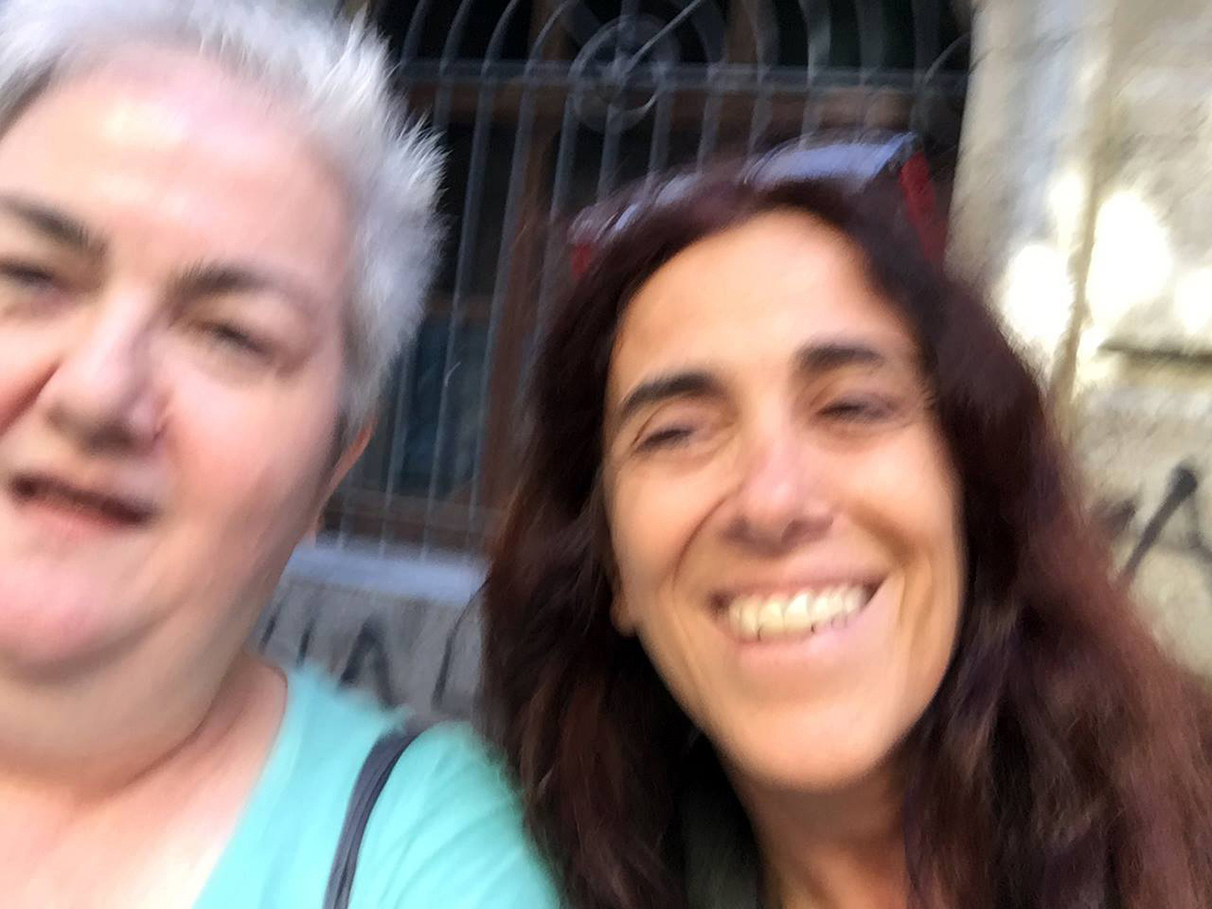
Day 11: Monday, 29 Ottobre 2018, a.m.
Napoli, Campania: Stazione Garibaldi, Metropolitana Linea 1.
Headed back to the apartment, I arrived at Stazione Garibaldi to the most taxing experience of my trip.
The ascensore (elevators) and scale mobile (escalators) were out of service, and men in uniforms with reflective safety vests were pointing people to the stairs. I couldn’t understand the guy’s explanation and figured I was being subject to an infamous Italian sciopero (labor strike).
The damned station is at least 150 feet underground and features four sets of elevators and four sets of stairs criss-crossing each other in a single, giant well that is open from the ground level to the tracks. I don’t like heights. The first time I exited Garibaldi station, I experienced nasty vertigo on the very long escalators out—which is why I had switched to using elevators (where you can’t see how high you are.)
This is the best photo I could find that is copyright-free (Thank you, Alpha 350.) Google other photos to get a stronger impression of how steep and dizzying these escalators and stairs are (45-degree angle.)
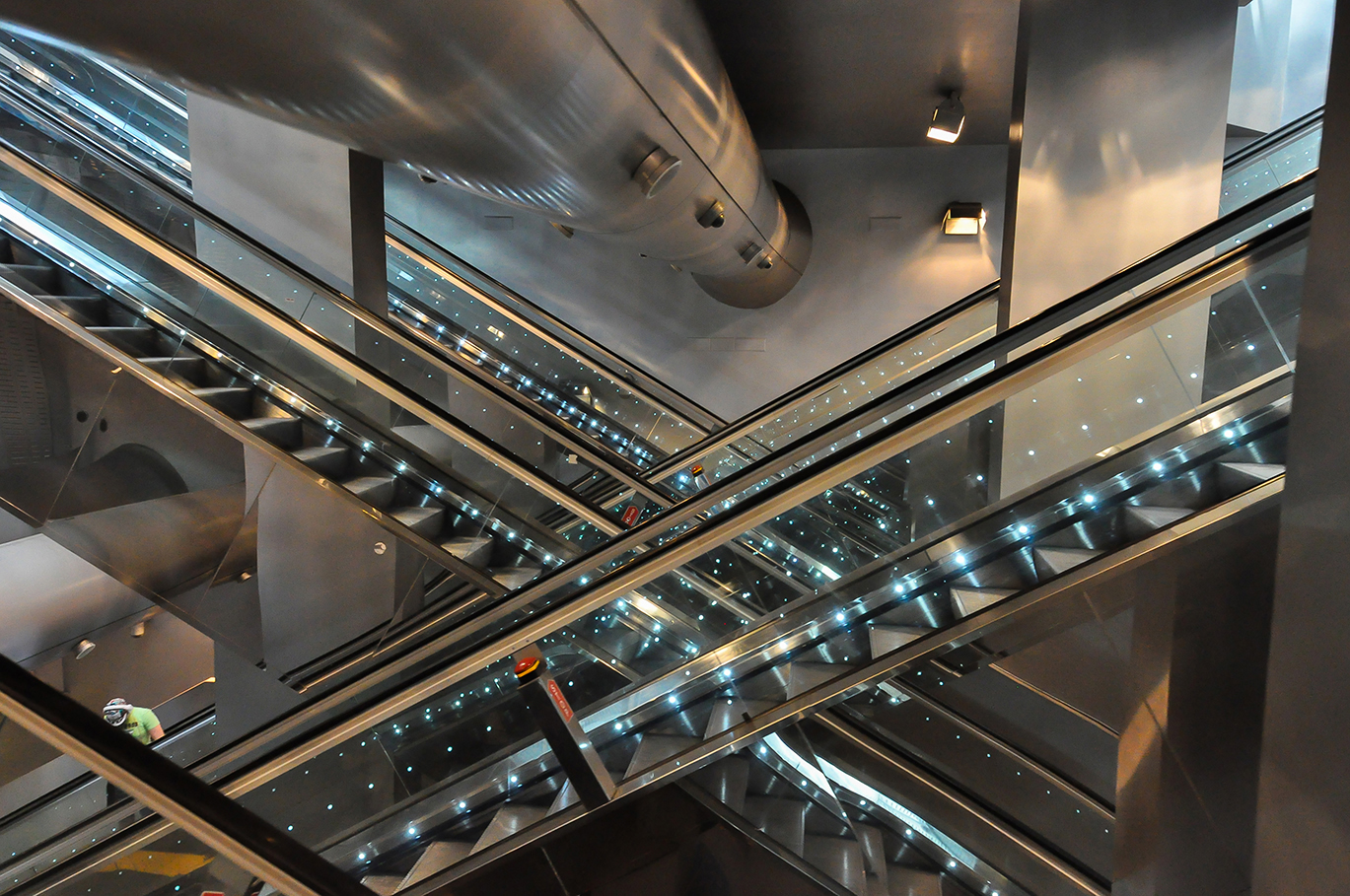
I said to myself, “Janice, pretend you have to do this to save your life, and just do it. Don’t look up, don’t look out, just look down at the stair treads until there are none left.” Resigned, I inhaled deeply and started up. It took about 10 minutes and wasn’t that bad, though I did have jelly legs for the rest of the evening.
I found out later the station was hit by a power outage.
During the 30 minutes that I was on the train, the whole city had been hit by a violent, windy thunderstorm—power lines down, roofs blown off, etc.
It was even reported in the New York Times, several friends from New York told me, with the mayor of Naples, Luigi de Magistris, calling it “an atmospheric earthquake,” whatever that is.
The lights in the station (of which there were plenty, no fewer than usual) must have been running on emergency generators. When I realized that, I wondered if the train had been running on generators, too, and quickly changed my attitude to “sure glad the damned thing made it into the station.”
I’ve worked for railroads, and I’ve taken their safety classes. I can tell you—enthusiastically—that I would be satisfied to never in my life experience walking in a train tunnel, in the dark, between tracks, with train personnel instructing me how to avoid hitting the third rail—thank you!
As the seven members of our party each arrived back at the apartment throughout the afternoon, we traded stories of waiting out the storm in museums, seeing loose pieces of roofs on the sidewalk in our neighborhood, and, for the family members who had returned to the apartment before it all started, closing the outside metal shutters and grilles on the windows, because the wind sounded strong enough to blow out the glass.
Later that night, we went out for pizza, and everything was more or less back to normal, surprisingly. Napoli has survived volcanoes. Not much else affects Neapolitani, apparently.
]]>Day 11: Monday, 29 Ottobre 2018, a.m.
Napoli, Campania: La Porta Capuana district, Via Cesare Rosaroll.
Back to Via Cesare Rosaroll and the slummy Troisi apartment with the whole gang. (See previous post for details.)
Lots of stunned silence—for the apartment and for the crappiness of the neighborhood in general.
We walked up Vico Cappella a Pontenuovo, a narrow street parallel to Via Cesare Rosaroll and Via Carbonara, to get a feel for an old neighborhood of Naples.
I’ve lived in un-modernized, cruddy tenement buildings in New York City, so this neighborhood didn’t faze me that much. Actually, I think it’s less bad than many inner-city neighborhoods I have seen (in the U.S. and all over Europe.) Some family members who are used to better housing were nonplussed.
What I did find wearying—claustrophobic, actually—after a week in Naples, and not just in this neighborhood, was the canyon-like narrowness of any street that was more than 200 years old and the overall darkness of buildings, sidewalks and streets, since the “local stone” is black, volcanic ash. Like this:
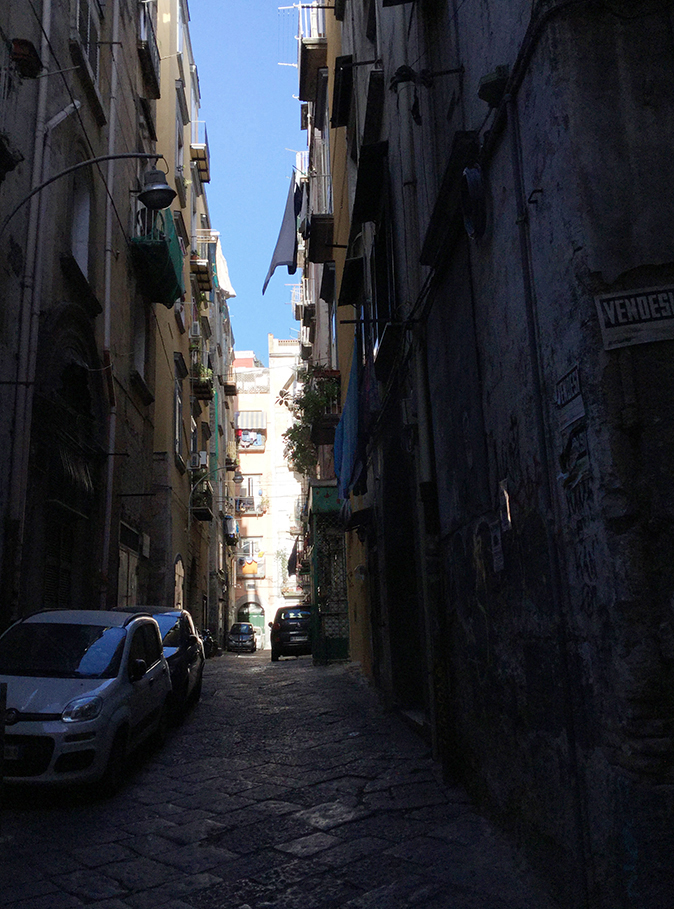
My favorite detail on Vico Cappella a Pontenuovo was the Spiderman motor cycle repair shop built into yet another tower of the former medieval wall of the city. See photo.
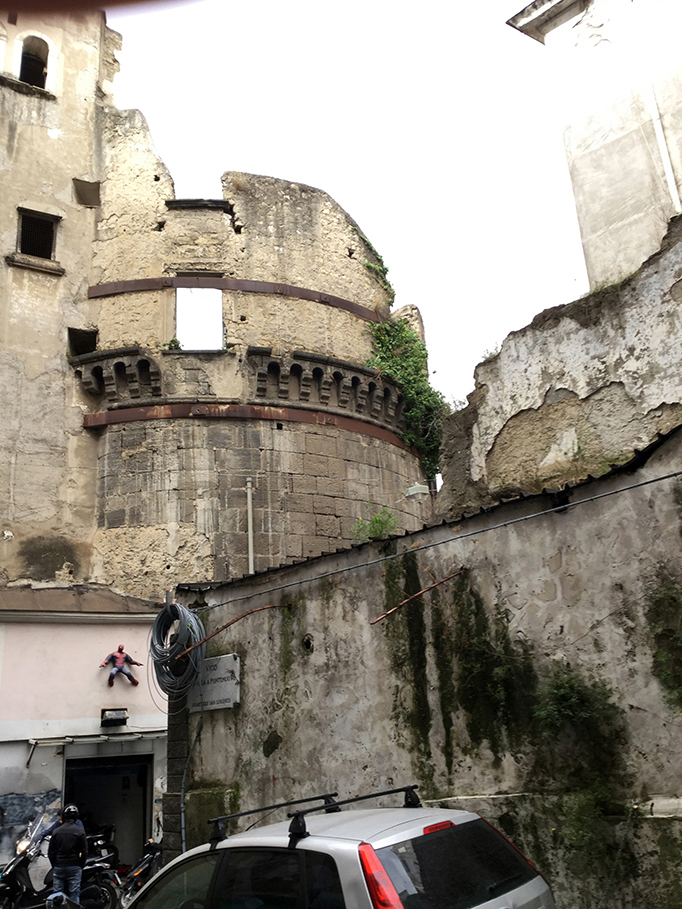
We saw these towers all over the neighborhood. Sometimes they were incorporated into later, substantial buildings, such as the well-known Garibaldi Barracks on Via Foria, and sometimes they had been turned into homes (!), such as the one shown below.

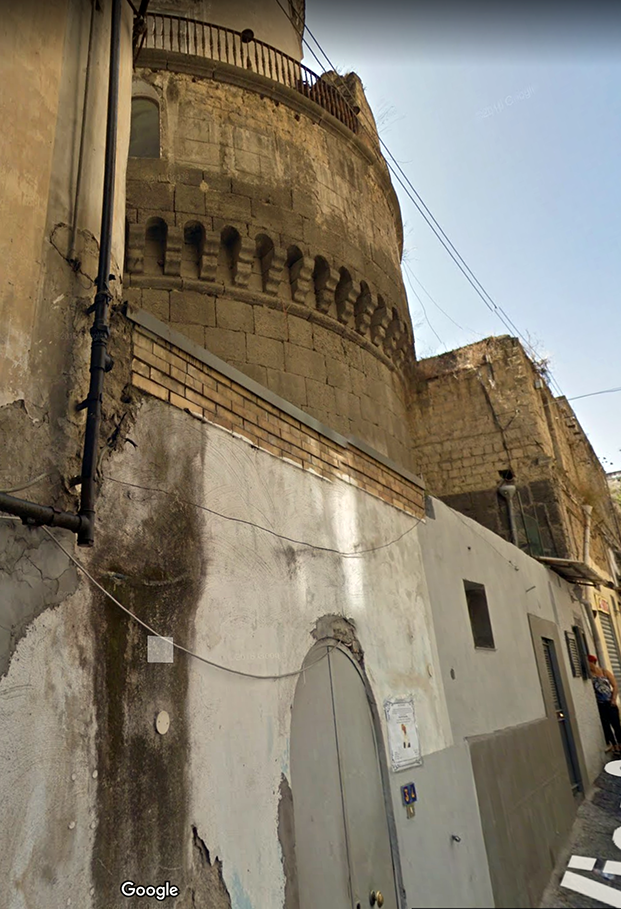
After the off-putting tour of the morning, we had a nice lunch to let everyone decompress, then we split to go several ways in smaller groups.
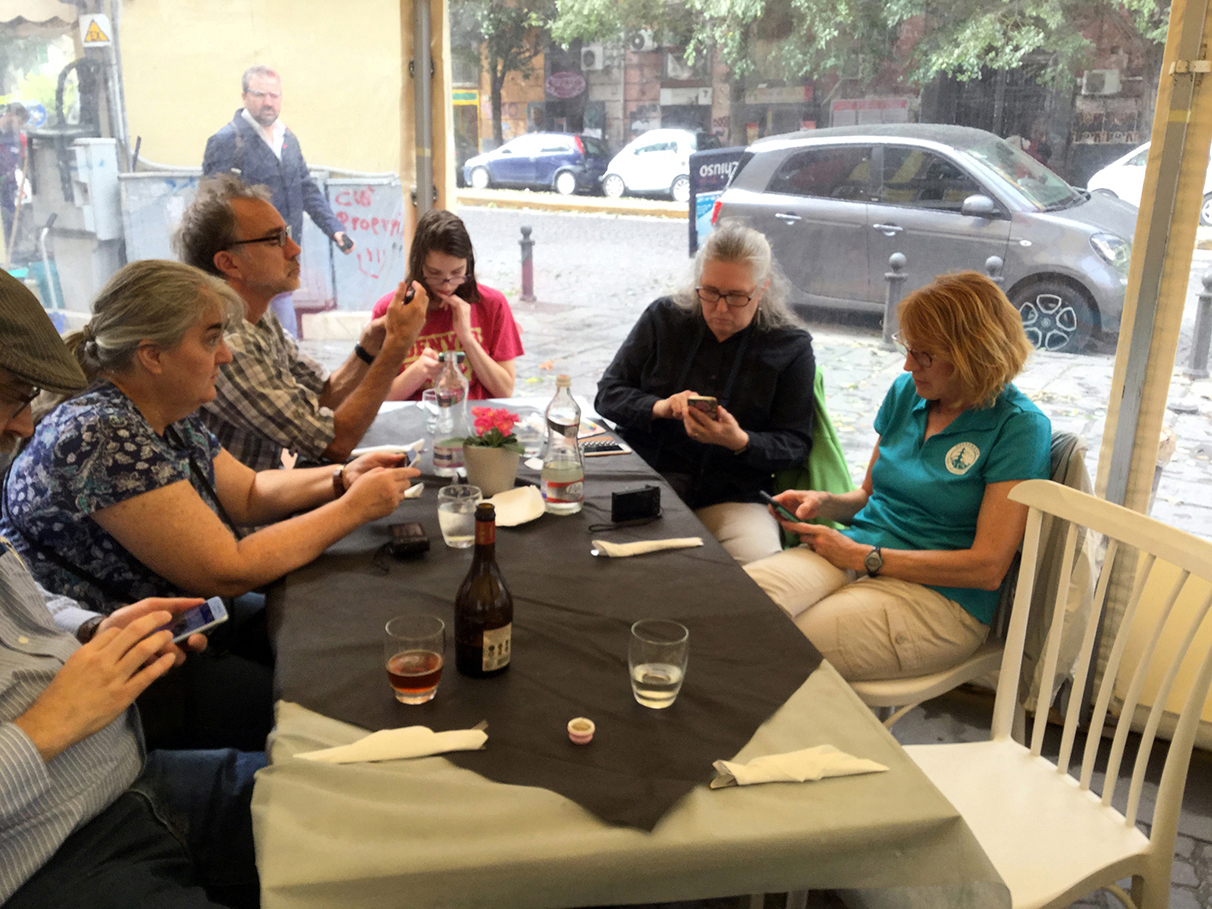
I headed south and west back into the old quarter to see Capella (chapel) Sansevero.
Giuseppe Sanmartino’s Veiled Christ is a stunning sculpture worth the money and effort, but the whole “attraction” is more cloyingly “touristy” than any other sights I had seen in Napoli, including the largest museums. I felt a tiny bit hustled, so I went into a “real” church afterward to relax for a few minutes.
Then I walked down the hill, explored a few new streets, and found myself on the musical instruments street that I had seen a week before with my Dutch friends. The “old” neighborhood is small enough that you can’t avoid repeating streets, I learned.
I headed to Piazza Dante and grabbed the metro to Garibaldi.
]]>Day 10: Sunday, 28 Ottobre 2018.
Napoli, Campania.
Sunday afternoon: family members arrive—two from Rome and three from Spain, joining one from Rome and one from Germany! The whole gang is now in Naples. We catch up on each others’ travels and make plans for dinner.
We can’t find the restaurant we chose from a guide book and “settle” for Avellinese food. It was fabulous.
A few nights later, when in Solofra, which is in Avellino, we ate at a “Neapolitan” restaurant. We couldn’t tell the difference, honestly.
Except that this category of not-pricey restaurants seems to always be overly lit, though I’m happy if they don’t have a t.v. blaring. (There’s often a calcio/soccer game on the t.v., but usually with the sound off which helps in ignoring it.)
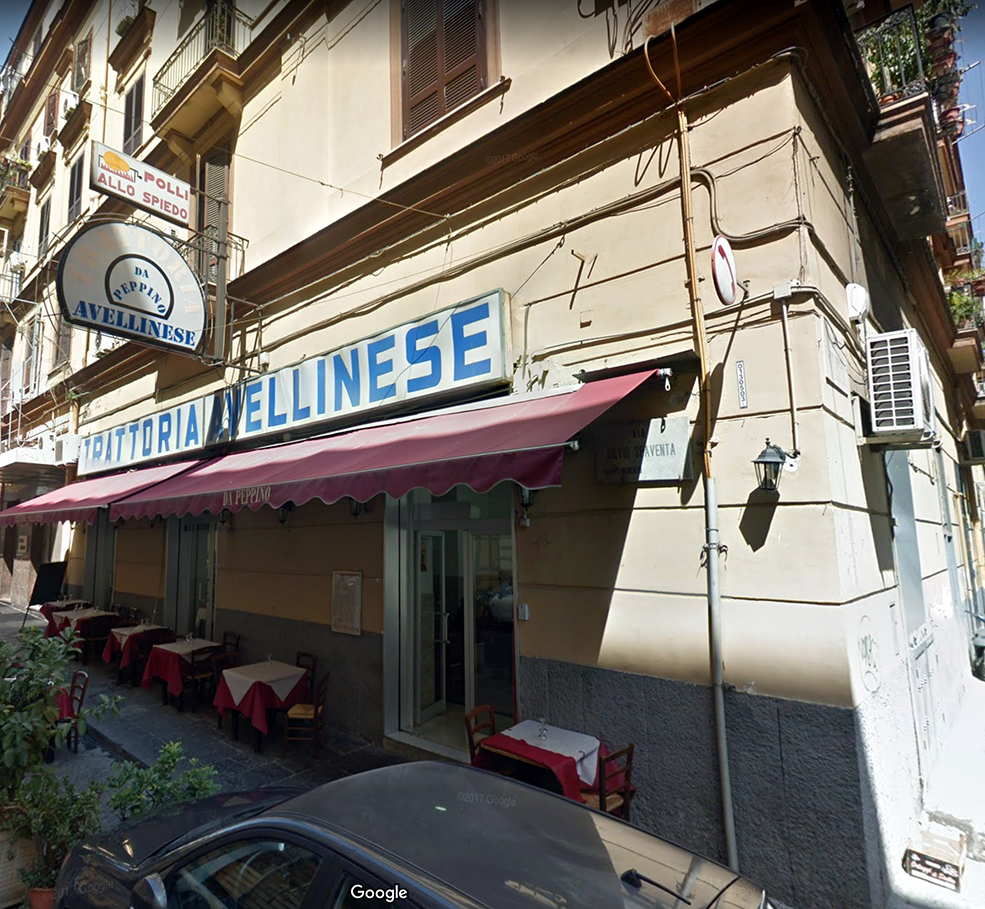
]]>
Day 10: Sunday, 28 Ottobre 2018, a.m.
Napoli, Campania: Capodimonte Museum.
Julie and I got up early Sunday morning and booked it to the Capodimonte Museum, as the 19th-century apartments of the former palace residents are only open two hours a week, and I was determined to see every 19th-century painting in this city that Donatus Buongiorno would have seen while he lived here—in case I could identify copies, inspirations, etc.
There were no “finds” regarding his painting career, but there was a major find regarding a police action Buongiorno initiated in New York City in 1907. He reported a studio theft to the police—that a “Van Orley” painting had been stolen, a portrait of Protestant reformer John Calvin, which Buongiorno and an Italian art dealer had imported from Italy to sell in the U.S.
Buongiorno wasn’t treated very respectfully, as the casual racism and yellow journalism of reports in the New York Times and New York Sun reveal (“artistic hair,” “very broken English”.)
Bernard van Orley (c. 1487–1541) was a leading artist in Dutch and Flemish Renaissance painting and a designer of Brussels tapestries and stained glass.
He (and/or his workshop) made many portraits of European royalty, including seven of Charles V, Holy Roman Emperor, after he became King of Spain, and… on this Sunday morning, I discovered that the Capodimonte Museum has one of them! (The museum also has a substantial tapestry series based on van Orley drawings and, presumably, Buongiorno would have seen those, too.)
This confirms how Buongiorno would have known about van Orley, but I still suspect he “got taken” on the imported painting, as I find no record of a Calvin portrait by van Orley, though the two mens’ lives overlapped and van Orley was, against the tide, a Protestant.
So the plot thickens, and I have one more fact to add to the stew.
Many thanks to my cousin Julie Holm who shot a better photo of this painting than I did and is letting me post hers.
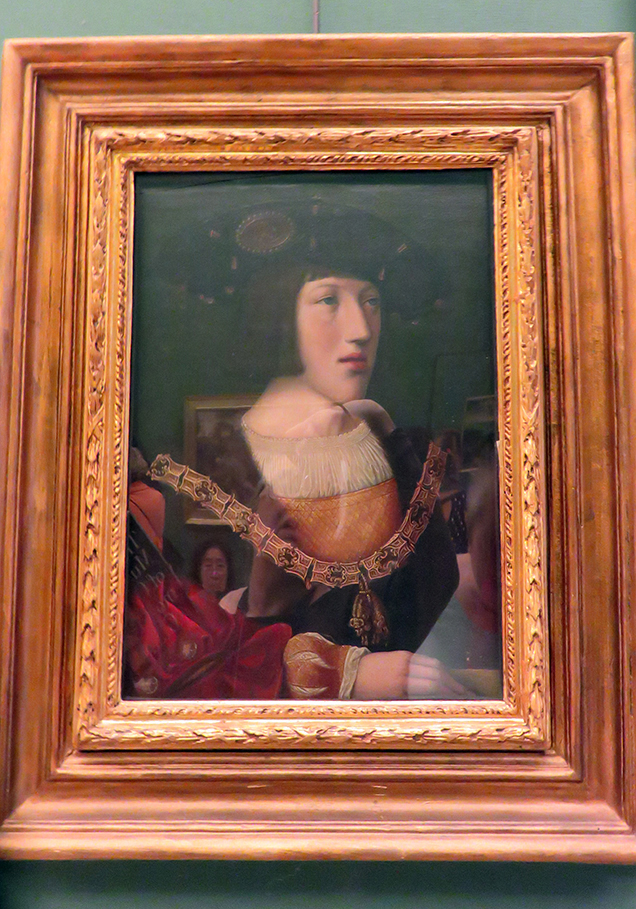
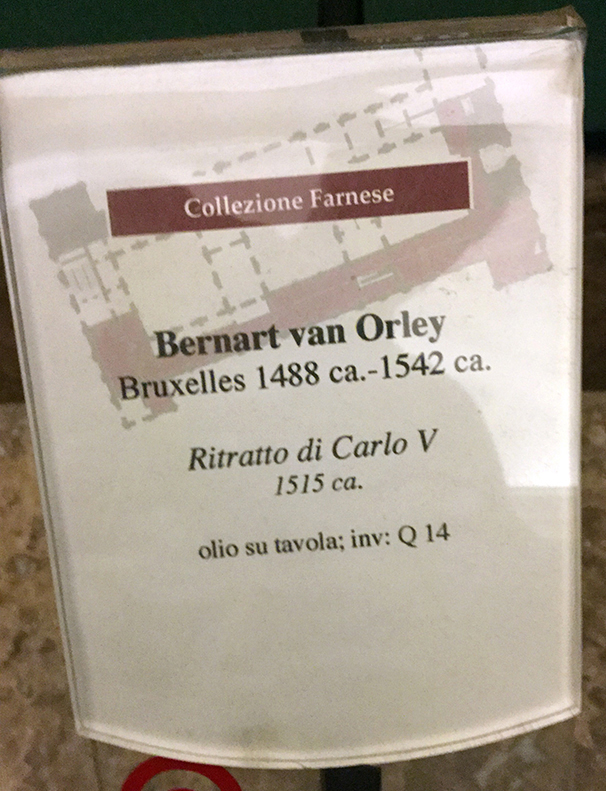
]]>
Day ?: Ottobre 2018, p.m.
Napoli, Campania: Corso Garibaldi.
I can’t remember which day this was, but the selfie is cute, and I wanted to put it in.
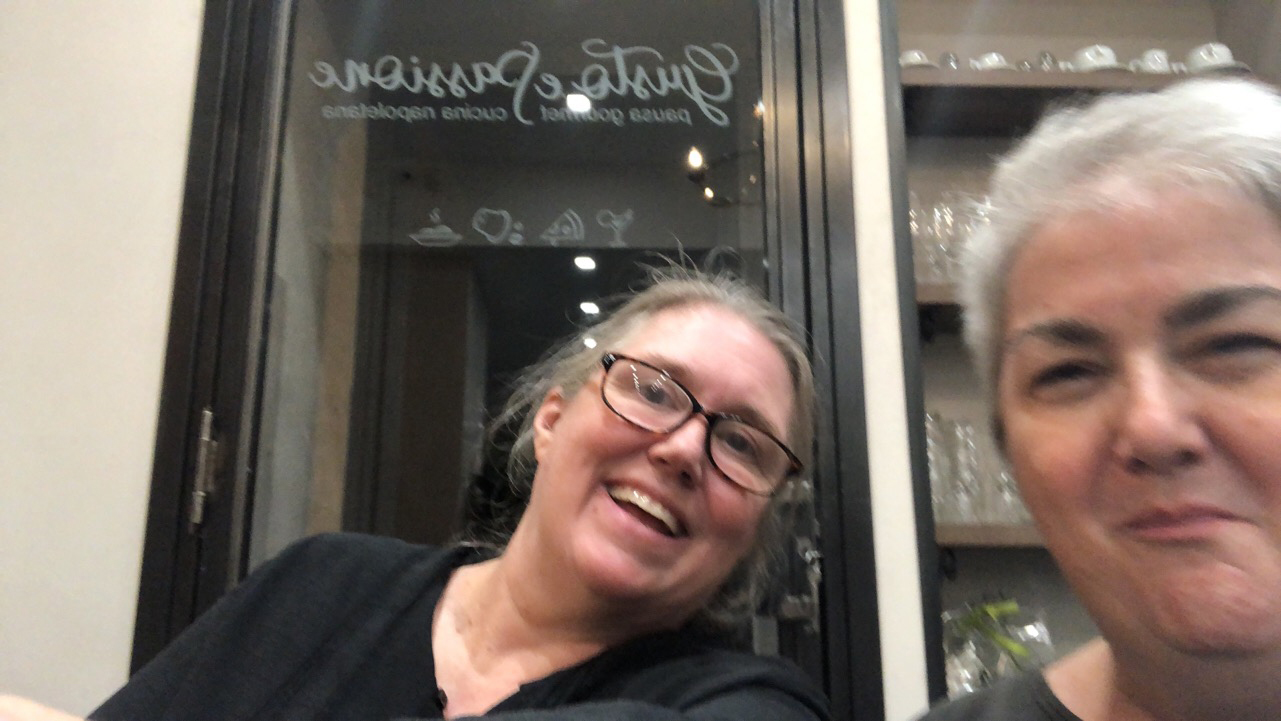
One night, Julie and I inadvertently crashed the family-only opening party of a new restaurant on Corso Garibaldi, a few steps from our apartment, right across the street from the Porta Nolana terminal station of the Circumvesuviana railroad.
We were hungry, and it looked good. There were quite a few people outside on the sidewalk and I said, “Oh it’s just the Italian smokers, we’ll cut through them.”
So we walked in. When we tried to navigate getting a table and menus, the (young) owner said: Don’t have any. We’re not open yet. But sit down and eat!
Then he proceeded to bring us drinks and taster-size food offerings, while children roamed around freely and nearby women made sure we had forks, etc.
They were so nice! And he wouldn’t let us pay him anything! He even insisted we take one dish with us, so we wouldn’t miss trying it.
Go there, people! The food was great!
Gusto & Passione
Corso Giuseppe Garibaldi, 42-43, 80142 Napoli NA, Italy
Phone: +39 081 1820 5856
]]>Day 8: Friday, 26 Ottobre 2018, morning.
Napoli, Campania: Il Sindaco al Palazzo Municipio.
I heard the mayor (sindaco) of Naples, Luigi de Magistris, speak in New York in 2015, when he made a round of visits to Italian American institutions to promote tourism to Naples. He was forthcoming, interesting, and charming.
A former prosecutor, he has a very interesting resume (Google him), and he’s a reformer with big plans for improving Naples. Indeed, only three years later, I experienced results of his work: garbage piles in the streets are gone, all of the subway stations are finished and open, and petty/preying street crime is down—thanks to military-style police with assault rifles who patrol in pairs in tourist areas (see blue circle in photo.)
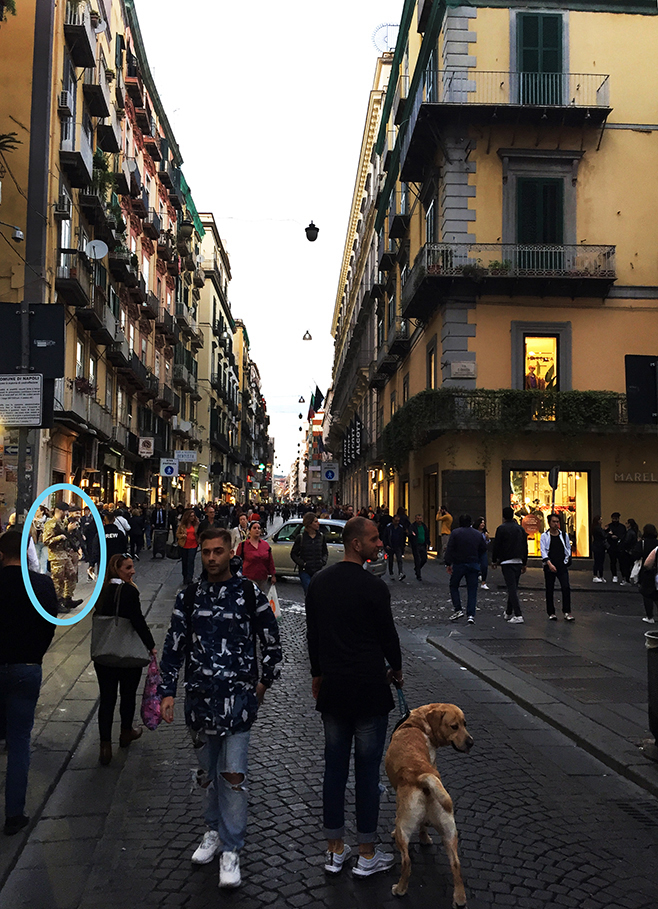
Since I heard de Magistris speak, I’ve had it in mind to bait his office when I visited Naples, because why not?
So I wrote to the man in New York who organized the talk I attended with my pitch: My family is visiting Naples as a result of de Magistris’s visit to New York. (Never mind that I’ve been researching my Neapolitan genealogy for 10 years, I was prepared to give de Magistris full credit for the trip.) After leaving in 1907, we are the first to return, and wouldn’t he like to have a film crew follow us around to make a tourist promotion? We will be very entertaining, and we will only say good things about the city. Plus I have this fascinating project about a family member who was an artist who left in 1892.…
The man wrote me back a very polite note saying not sure about your proposal, but here’s the name of de Magistris’s assistant with whom I made the New York arrangements.
Pay dirt!
I wrote to the assistant: “My family is visiting Naples, and….”
She wrote back “We don’t have a film crew, but would you like a tour of city hall?”
Hell yes!
So Julie and I went to the Palazzo Municipio on Friday morning to check out the tour and see if it was worth doing again with family members the following week. We decided “no” for the family (not germane, limited time), but we had a blast.
Here’s the outside of the building.
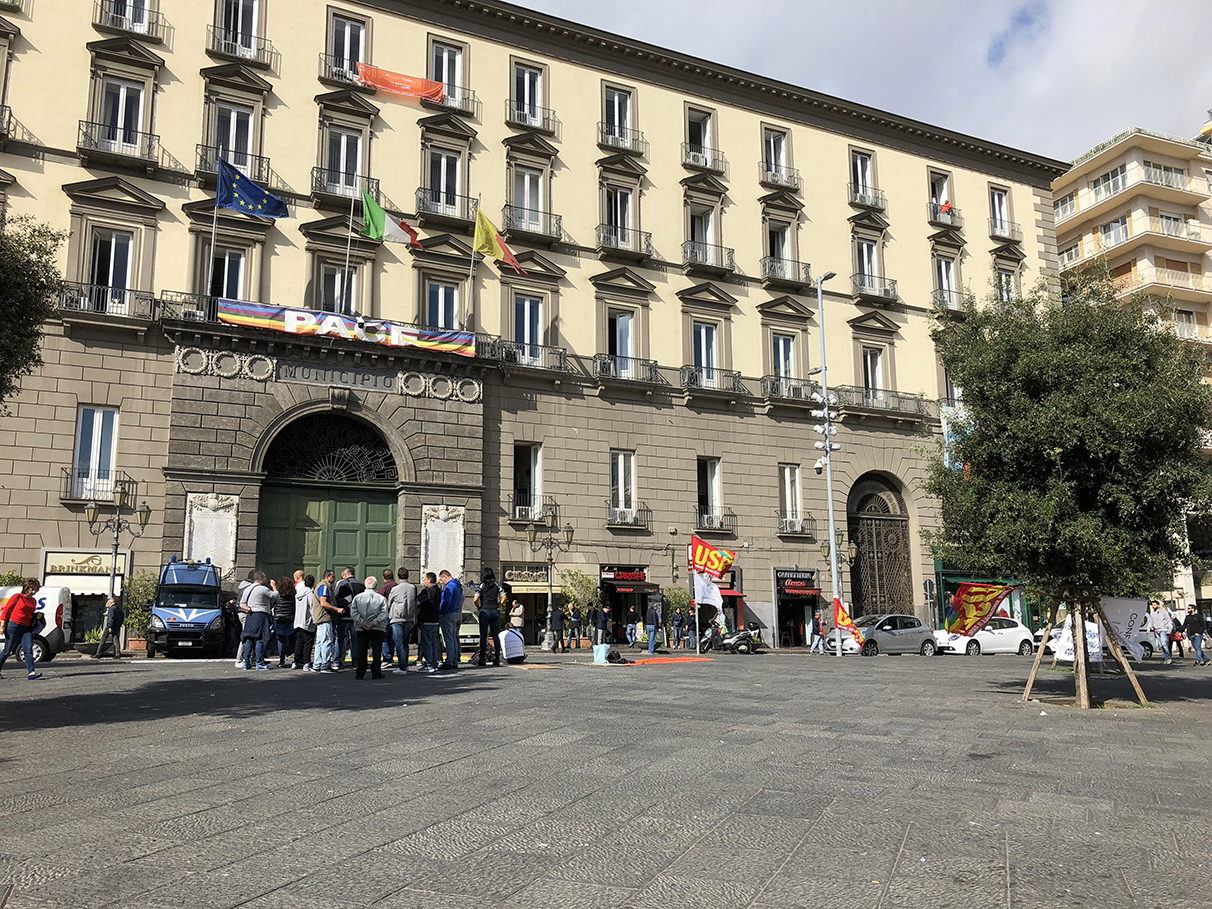
We walked up to that gaggle of police officers around the green door, and I announced, “We have an appointment with Il Sindaco.”
Not this door. Go around to the side.
So we go to the side and talk to the municipal officers who are smoking cigarettes. “We have an appointment with Il Sindaco.”
They make some phone calls and yell to other people who are further inside and go back to smoking.
We wait. We wait. We look at each other: not sure we are going to get in here.
Then these two youngsters appear: Alessia Andreottola and Dario Riccio. They are our guides.
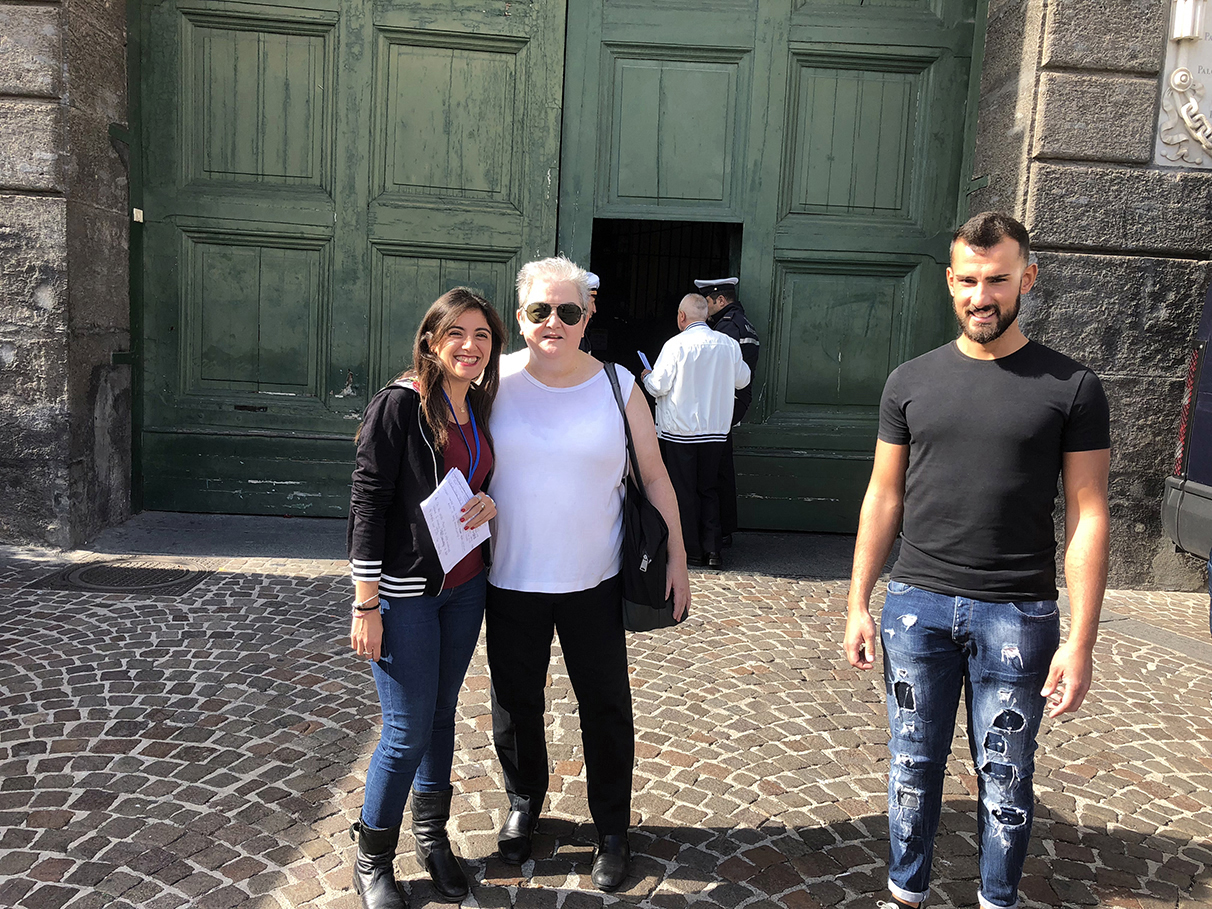
We walk in. No bag check. No pat down for weapons. No passports, no IDs. No security whatsoever. Interesting.
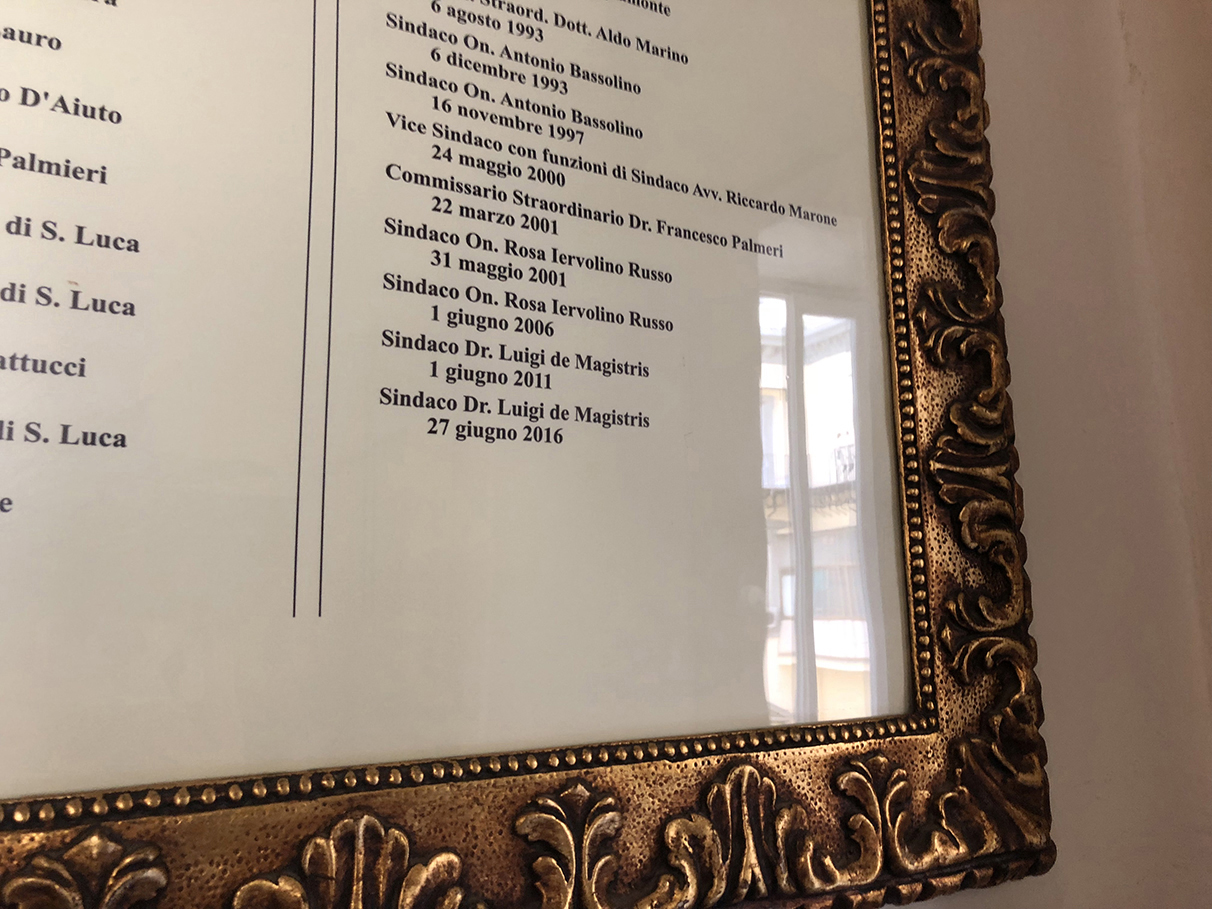
The palazzo is one of the many royal houses, or offices, or something, that were left over when Naples became a not-royal city upon the unification of the country. It’s a fancy building, with fancy rooms, and fancy decorations all over the walls and ceilings. Paintings, sculptures, and decorative objects everywhere.
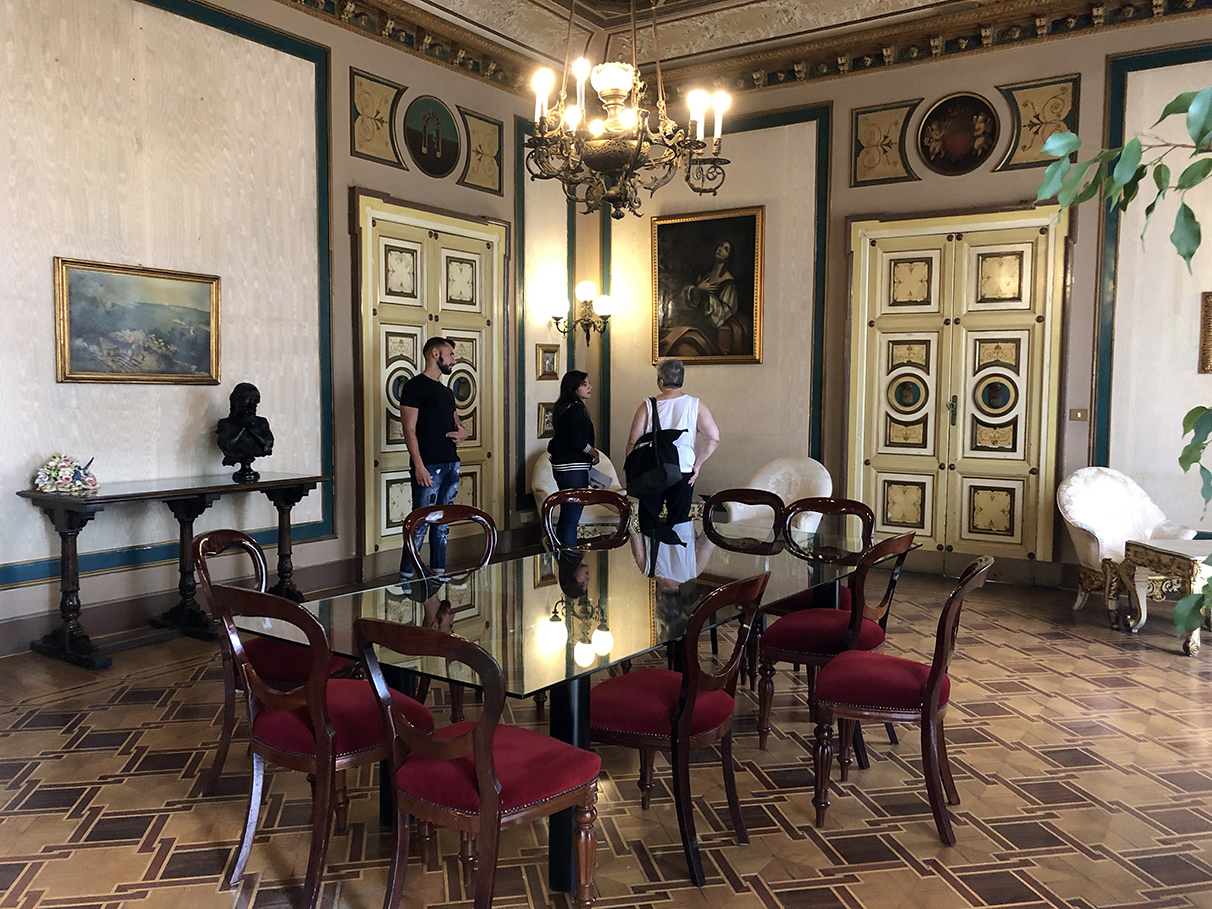
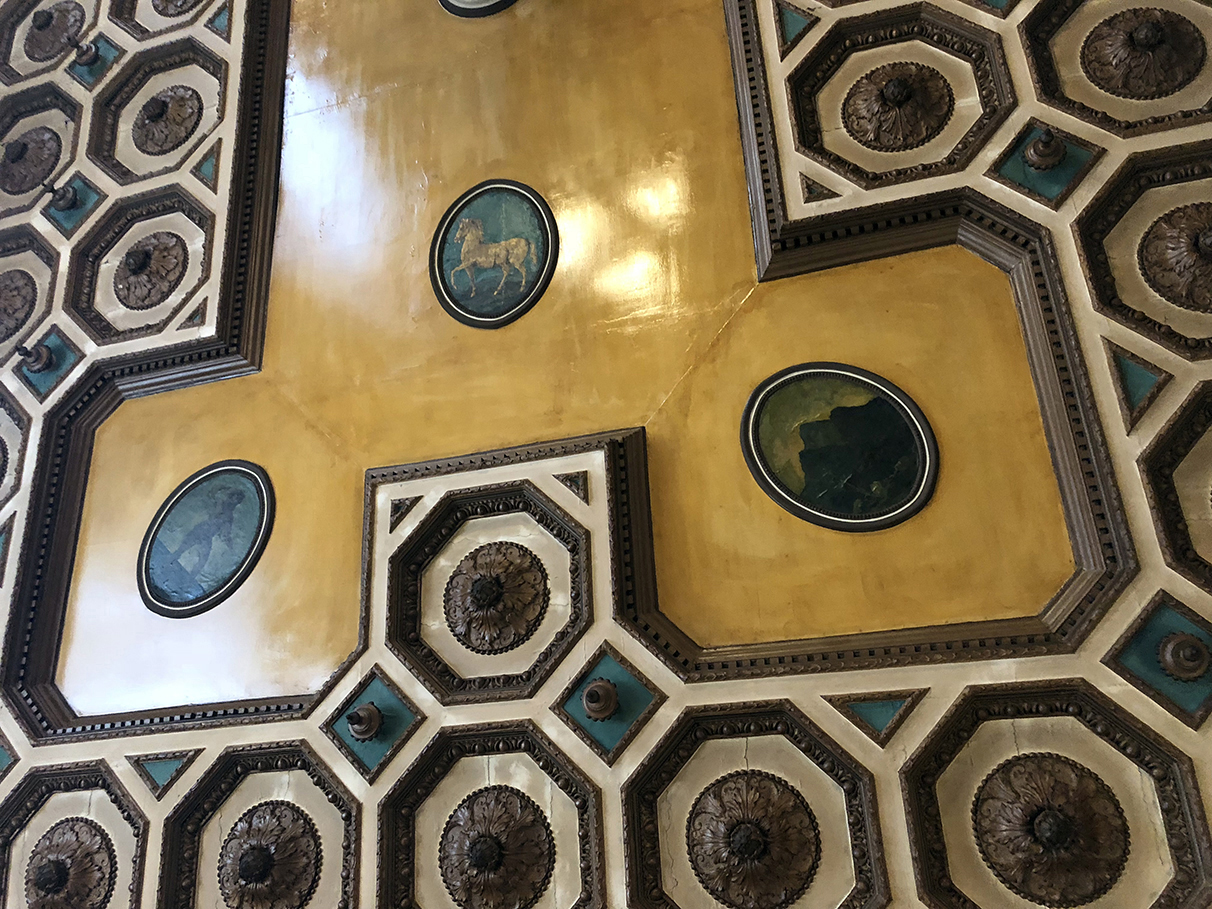
There’s even a Precepio. Apparently Christmas lasts year-round at City Hall.
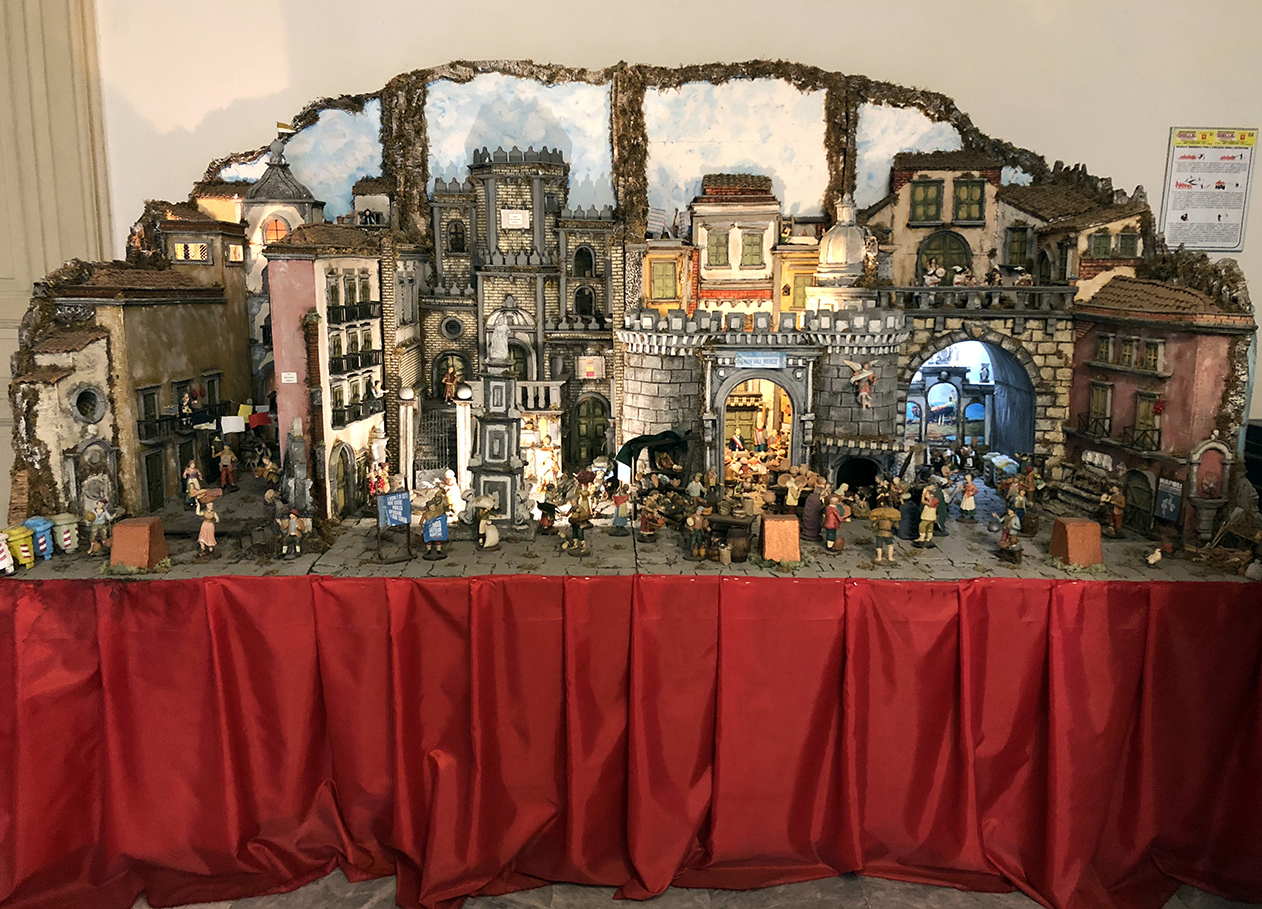
At one point, we stood outside a room full of people and looked at their heads from the hallway. Signor de Magistris is in there, but he’s doing a press conference, so you can’t meet him. Now we’re in an Altman movie: cue soundtrack of action in one room, talk from other room washing over us, people near the door turning around to “Shhhhh” us.
Would we like to see his office instead?
Sure.
We enter the corner room, filled with ornate furniture, and, on every surface, including every square inch of Signor de Magistris’s desk, are mementoes and tchotchkas with his name on them. Gifts from all quarters, apparently. Julie whispers to me, “He must have another office, too. Doesn’t look like much work gets done in this one.”



Look at that 19th-century painting. Could it be a Buongiorno, pleeeeease? (Not.)

Would we like a photograph of his desk. “Umm, okay.” We take one. No, would we like to SIT AT his desk. (So we can slip the plastic explosive under it more easily?) Surrrre. So I played potentate, and Julie stood behind me, and our guide shot a photo.

Who do they think we actually are, we wondered? (We didn’t notice anyone following us the rest of the day.)
Go to Naples, people! You can tour the mayor’s for-show office!
While I was chatting with the minders to distract them, Julie snagged a great shot of the newly re-opened Piazza Municipio from the mayor’s fourth floor window. Note the 1930s port building (behind the yellow crane) on the cruise ship docks beyond, and cloud-covered Mount Vesuvius 5 miles away.
De Magistris gets full, well-deserved, credit for the reconstruction of the piazza and for construction of the Metro station underneath it (note red M sign on pole and discreet entrance to station–stairs down surrounded by cement retaining wall–in front of the building on the right).

Here’s the obligatory selfie. A million thanks to my cousin Julie Holm who shot all these photos.

]]>
Day 8: Friday, 26 Ottobre 2018.
Napoli, Campania: Vomero Hill.
Cousin Julie and I, who are doing advanced scouting for a condensed visit with family members who will arrive in a few days, decided that seeing this view from this Naples hill is a must-do/must-see, so we are re-arranging the group schedule to include it next Tuesday when museums will be closed. Julie shot the two panorama photos (with her extra phone, which she had lent to me, but then I gave it back—our identities were a little blurred at this point).
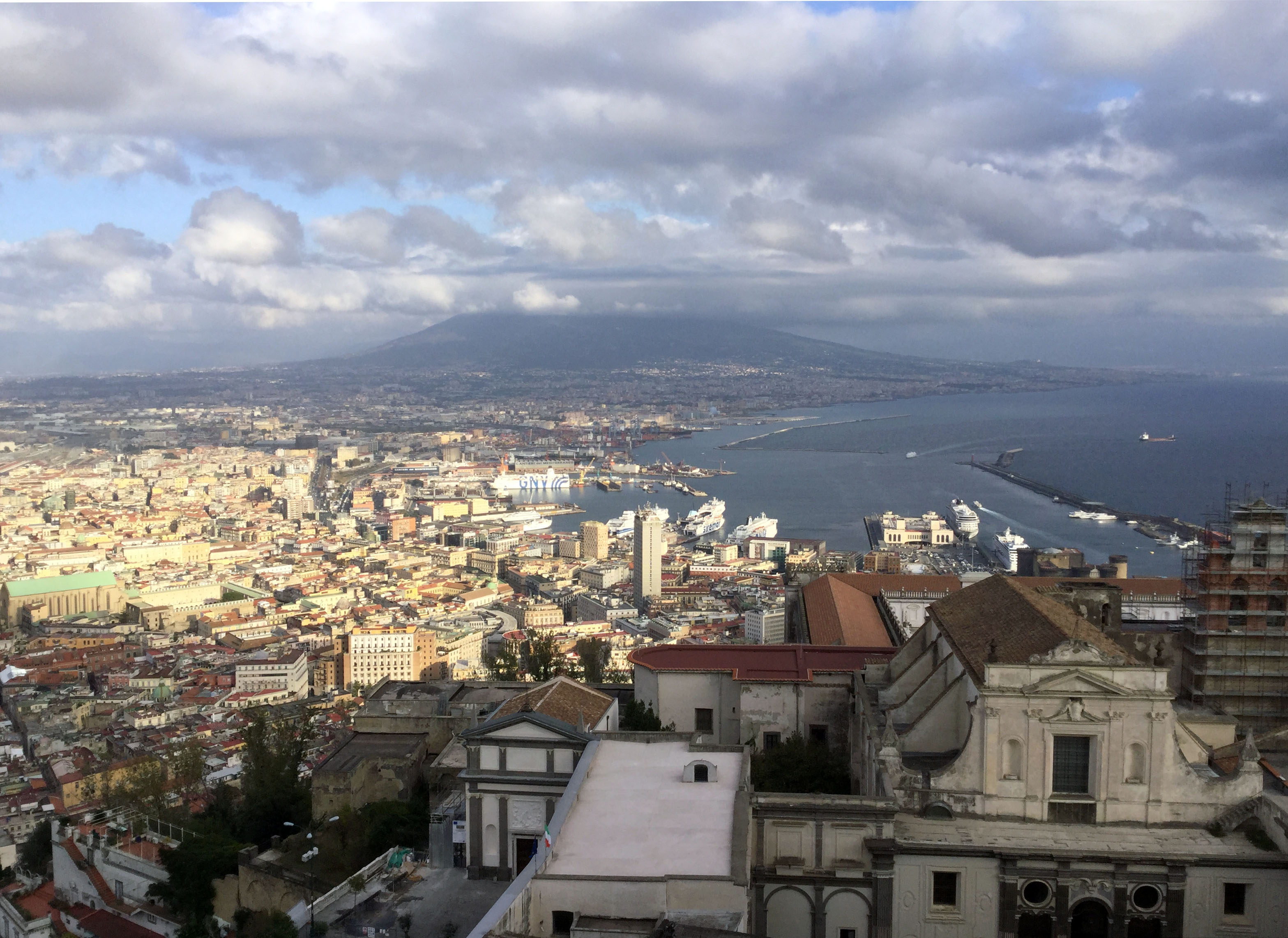


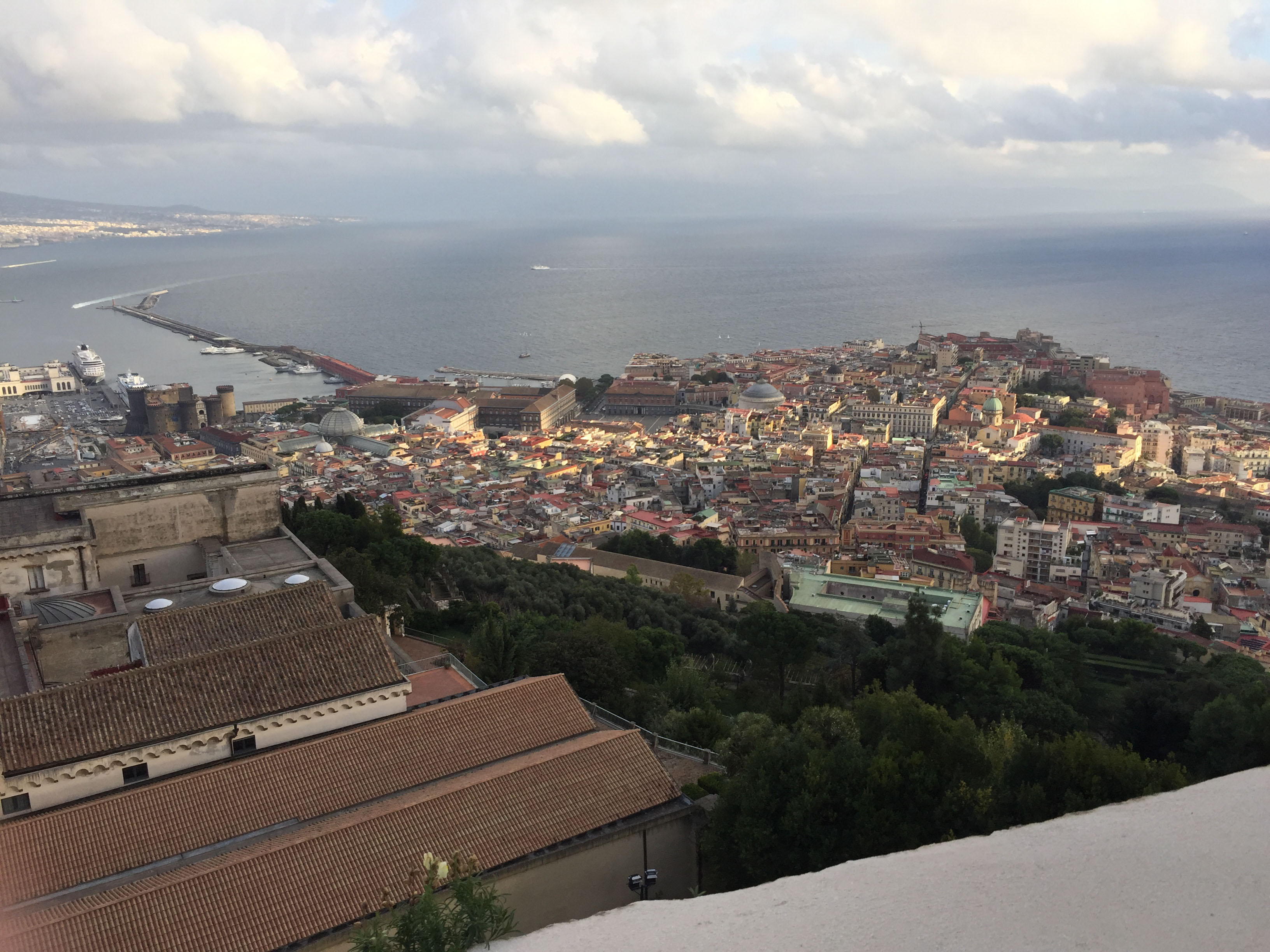
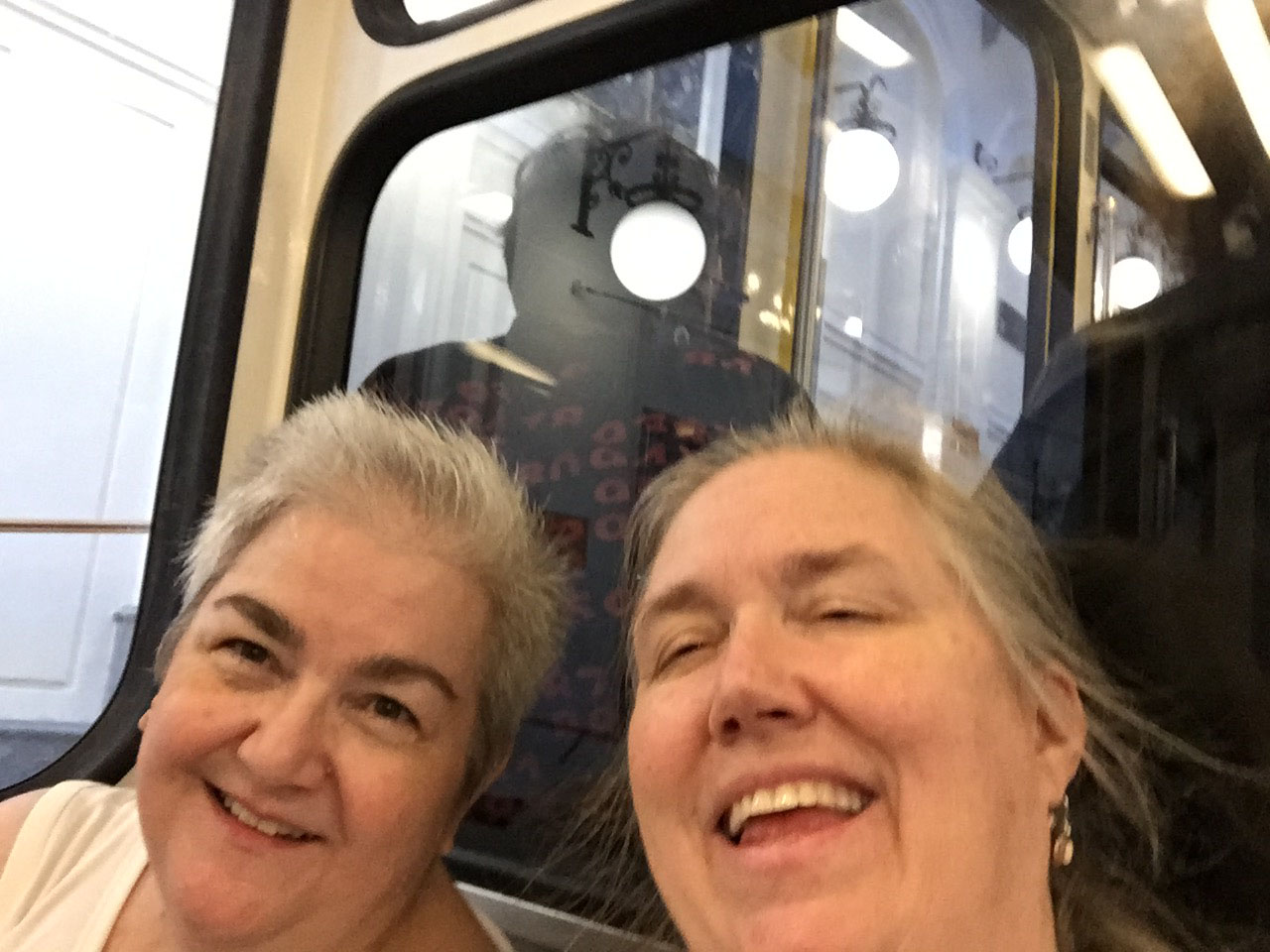
Day 7: Thursday, 25 Ottobre 2018.
Napoli, Campania: Via Cesare Rosaroll, 8:00 p.m.
Dinner?
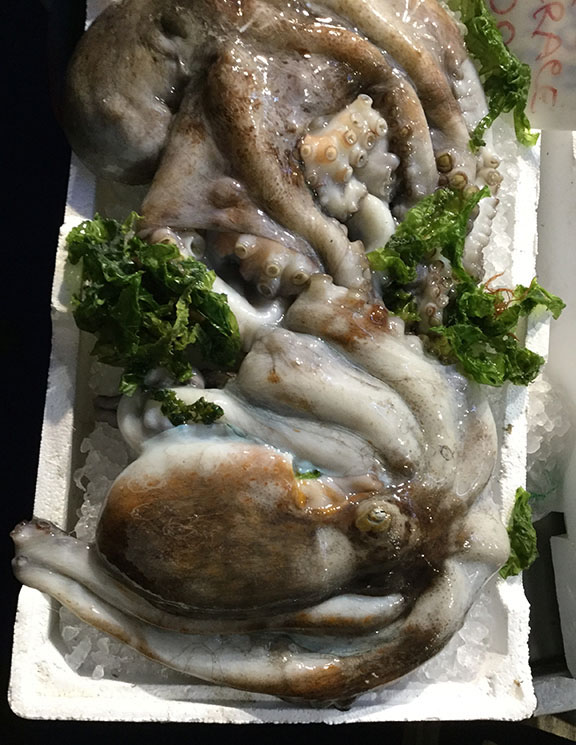
Day 7: Thursday, 25 Ottobre 2018.
Napoli, Campania: La Porta Capuana district.
My grandfather told us (in his 1970 self-published memoir) the street where his family lived, but not the building/apartment number. I hired several people to pursue different avenues to get that elusive number, and one paid off. (Shout-out of thanks to Vincenzo Regina of Istituto Araldico Genealogico del Regno di Napoli.)
5:00 p.m.: I announce to my cousin Julie, “I just got the notice from my hired researcher. Maria Michela Buongiorno (Troisi) died in her home located in Vico Santa Caterina a Formiello n. 3.”
We immediately look up that address on Google Earth.
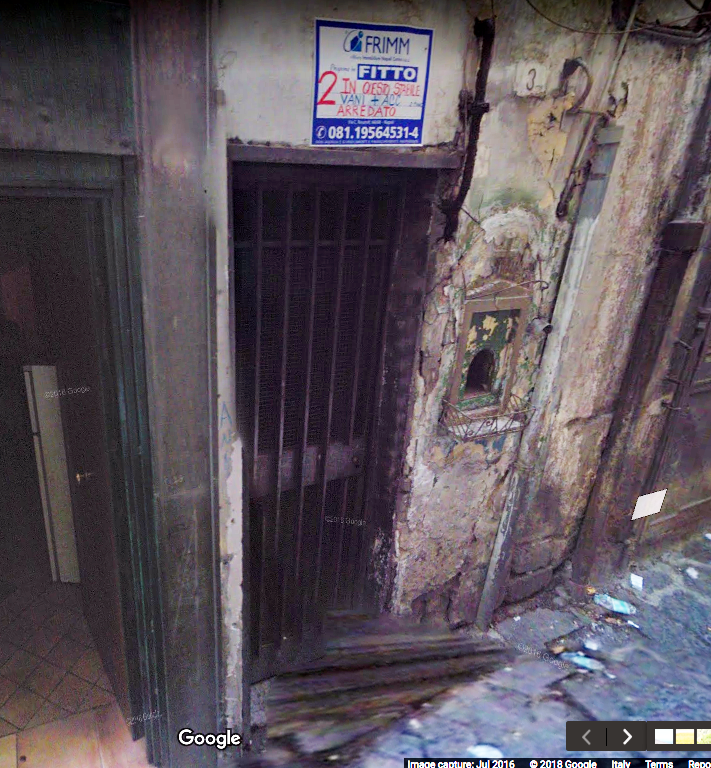
It’s bad, people. It’s a tiny hovel of a doorway, a few crooked steps above the street, across from a toilet paper store. (Seriously, the store is even labeled “paper” on Google Earth.) Currently not occupied and possibly for rent or for sale (see sign in photo)—anyone, anyone? Not directly on Via Cesare Rosaroll, but in a nearby alley. No wonder Domenic Troisi (my grandfather) had no complaints about a 4-room tenement flat in New York City (in 1907) and so enjoyed his later, self-built, 4-bedroom home in Williamsport, Pa., in the 1920s. The man did well for himself in the U.S., eh?
5:01 p.m.: Julie says, “Let’s go look at it. Right now.”
Update, later in the evening: Wrong door. The grilled door on the right is to the building’s common hallway and stair to upstairs apartments. (Totally dark, filled with trash.) The apartment is the OPEN door to the left—where you can see the current occupant’s refrigerator just inside (on Google Earth, but she has moved it since.) It’s the size of a small Manhattan studio apartment—no smaller than some I’ve lived in—but 4 inches above the street, with a single wooden door between her and and a public street while she sleeps. What you see in the photo below is about the full width of the entire 4-story building, by the way, so the apartments upstairs may not be any wider.

The currently inhabitant is a woman from the Dominican Republic (to the left in the photos, the woman to the right is her friend who lives elsewhere) who has lived in Italy 20 years. She very graciously chatted with us a few minutes, while cars whizzed by my back a few inches away and cousin Julie discretely took a few photos. (Thanks for the use of your photos, Julie.)
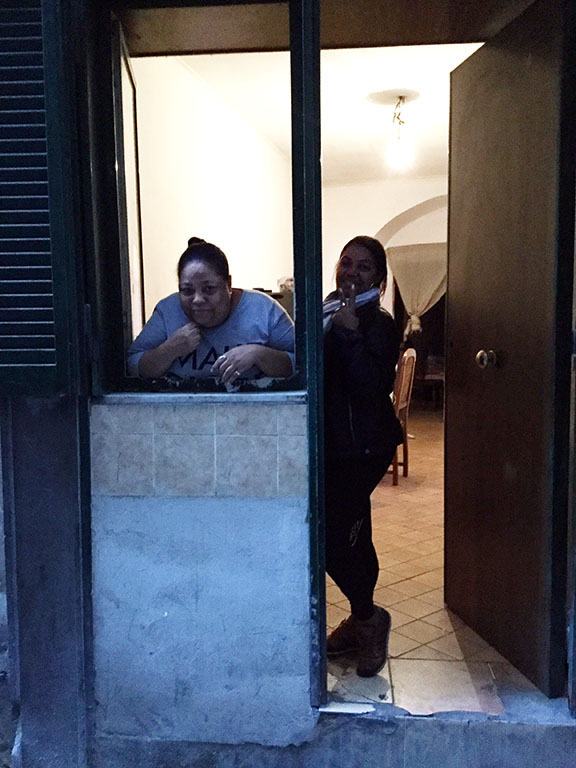
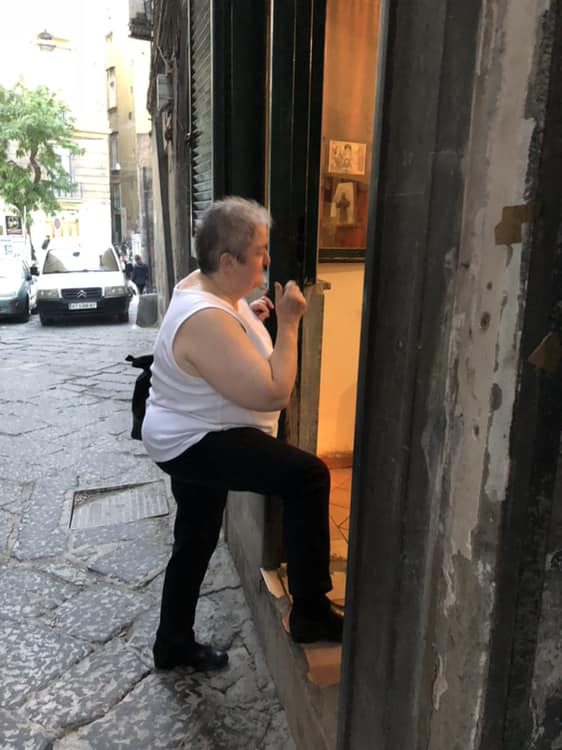
Troisi cousins note that the apt matches Domenic’s description for magazino in the front, living quarters behind a curtain in the back. You can see an alcove with curtain to the right of her friend in the doorway photo. The current tenant has an electric refrigerator and nary a wood stove in sight. We did not ask if her toilet is still out in the hall (which our grandfather reported in his memoir).
The last photo shows a chapel on the street that we think must be the one Domenic referred to in his memoir.

By the way, the “toilet paper store” across the street, which I jokingly identified based on stacks of toilet paper in the Google Earth image? Sells only paper. We confirmed it. I feel compelled to include the photo as proof.
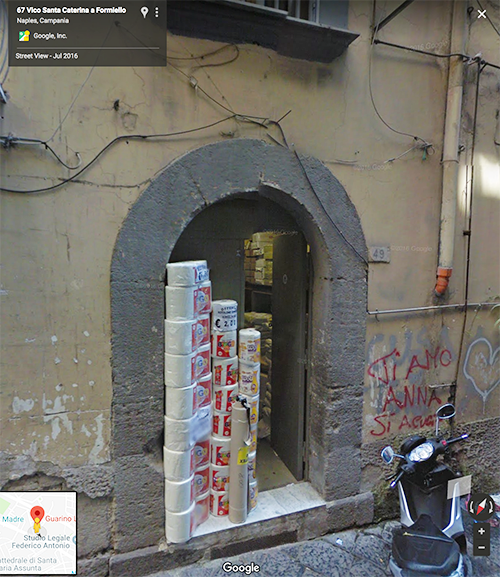
See posts by my other family members on Facebook for photos and videos taken during daylight on the day we all visited together, including this good overview by my sister Loraine. Thanks, Loraine.

Day 6: Wednesday, 24 Ottobre 2018.
Napoli, Campania: From the apartment in La Marinella district.
My first view of Vesuvius from the apartment!
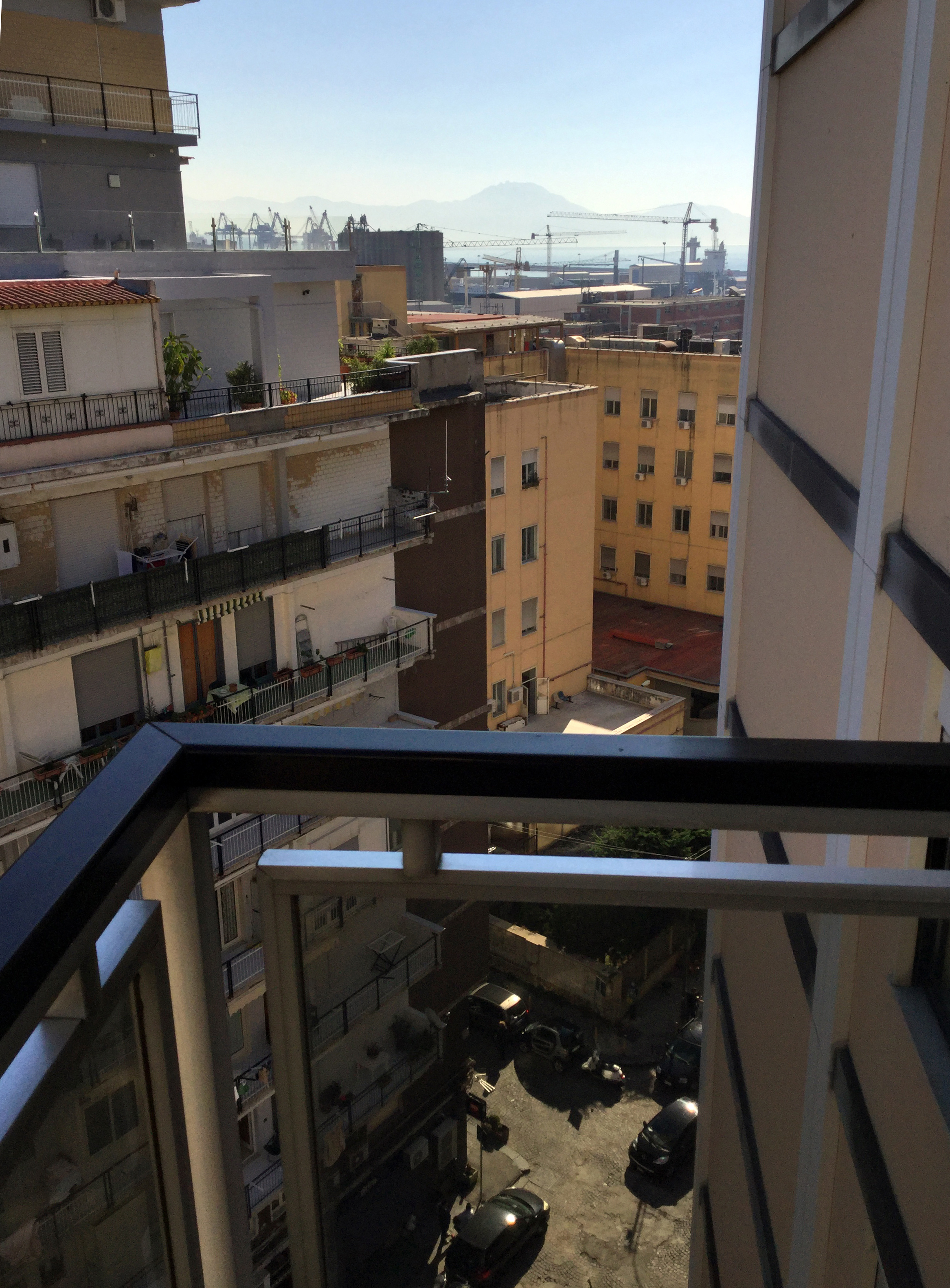
Day 6: Wednesday, 24 Ottobre 2018.
Napoli, Campania: Museo Archeologico di Napoli.
My first view of Vesuvius! From the archeology museum. (The weather’s been cloudy. Views have been lousy ’til now.)
Taken from an open window on the top floor. My Dutch friends who are with me are outraged that this room containing frescoes from Pompeii has windows that are open to the elements as we stand here. “Don’t they know anything about climate control and conservation?!?!” (Yes, they do, but this is not a wealthy country like The Netherlands….)
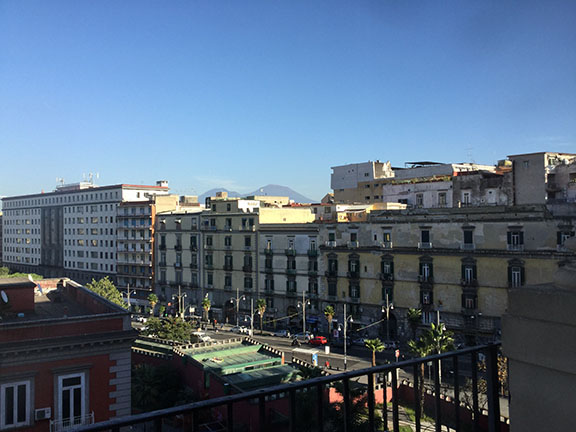
Day 5: Tuesday, 23 Ottobre 2018.
Napoli, Campania: Palazzo Zevallos Stigliano, Via Toledo.
In the week before my family arrived in Naples for our “roots tour,” I viewed every collection of 19th c. paintings in the city, part of ongoing research of my ancestor painter Donatus Buongiorno—wanting to “see what he saw” and understand his visual education.
The collection at this mid-sized gallery includes a “famous” maybe-Carravagio, 17th- and 18th-century paintings that would have informed Buongiorno’s work, as they were most likely on view somewhere else in Naples (possibly Museo Pignatelli) when he lived and studied there. This gallery, opened only a few years ago, is a re-arrangement of paintings owned by a Neapolitan bank.
Plus, the gallery is in a former palazzo, and I’m always a sucker for architecture.
Rooms of more recent art contained late-1800s pieces by Buongiorno’s contemporaries and teachers from the Accademia di Belle Arti di Napoli, including a beautiful bust of Domenico Morelli (by Vincenzo Gemito, number 8 in the slide show at the bottom of the website page), an influential art educator of Naples who was an instructor in painting at the art academy when Buongiorno attended and who later became the academy’s director.
Unexpectedly, I was jolted, and thrilled, to see pride of place given to a painting by Francesco Guarini (or Guarino)*, 1611-1651 or 1654, who was a painter from Buongiorno’s home town of Solofra, Avellino.
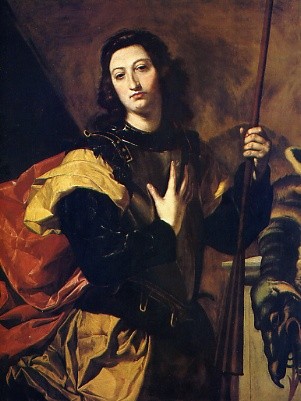
Giovanni Tommaso Guarini and his son Francesco Guarini painted the murals on the ceilings of their famous, 17th c. Neapolitan Baroque hometown church La Collegiata di San Michele Arcangelo.
If nothing else, having this painting in this gallery’s collection helps secure Guarini’s importance as a southern painter and draw some attention to him, and to Solofra, in the big city of Naples.
*There’s debate over the painters’ last names being Guarino vs. Guarini. Here is a Google translation of the last paragraph of the Wiki article:
It is not yet known precisely what the last vowel of the original surname of the artist is. Although this debate, reopened on the occasion of the celebrations for the four hundred years since the birth of the Solofrano painter (1611-2011), seemed to converge towards the final choice of “Guarini”, some scholars reiterate the thesis that it should instead call it “Guarino”. In the publications of various authors both definitions are used, therefore it is possible to define both Guarini and Guarino, without making mistakes.
As there is a Guarino in my Troisi family tree—Maria Vincenza Guarino, 1824-1866 or 1883, mother of Beniamino Mimi Troisi—I declare her to be a descendant of these two painters and, hence, another source of the substantial artistic abilities manifested by multiple generations of my family.
]]>Day 4: Monday, 22 Ottobre 2018.
Napoli, Campania, La Marinella neighborhood.
Train from Rome: Notes for family members who are duplicating this trip in a few days.
There are two train companies that run trains from Rome to Naples. One costs 12 euros and is the “local”. Takes 3 hours, stops at 8 or so towns along the way, including several outlying areas of Naples that we were told are known for drug dealing where dealers and beggars get on the train to transact business and harass passengers. We were told that the trains are old, crappy, not maintained inside, broken seats and you might not get a seat and have to stand the whole way.
We saw the interior of one of these trains as we were leaving the platform in Naples, and it looked no worse than your typical NJTransit or LIRR train to me.
Side note: There is a palpable prejudice against “southerners” in this country. Every single Roman who gave us “advice” about Naples railed on and on about how frightening everything would be. Plus, I am writing this a day later and have spent a whole day walking around the city already. No problems! I think the nasty reports are exaggerated. Yes, we saw a few beggars. No, they were not that aggressive.
The other company is Italotreno.it. Costs 40 euro and is worth it. Takes 1 hr 10 mins, stops once, is a fast, smooth, pleasant ride. I recommend it highly. Brand new tracks, even the gravel they are set in looks clean. For those of us who only know train travel on 100+ year old tracks of the northeast corridor of the U.S., this is a revelation. I watched the train cross two lines at a switch at one point, and you could only barely feel the bump from within the car. I especially encourage Dave H the engineer to choose this option for the “infrastructure experience.”
Plus, we went through, and got glimpses of, this exciting, spectacular, new Napoli Afragola station by architect Zaha Hadid!!!
You can book at their website (assigned seats), but it’s not a smooth interface and took us an hour. Honestly, I think we could have done as well just showing up 20 mins early and buying the seats at the station. We traveled at noon on a weekday and the train was full but not completely sold out. Both stations have segregated spots for buying tix that are less busy than the general station and out of traffic, so you don’t feel nervous handling your cash, credit card, etc.
Speaking of which, no problem using American credit cards to buy stuff so far. Even the tabacchi stands take cards for bus tickets—1,50 in Rome, 1,10 in Naples. (Everything is cheaper in Naples, sometimes by half. Wait ’til you get to Naples to buy routine stuff, if you can.) Last night I used a credit card in a small, family owned restaurant—though I had to go to the “special” cashier to do it which was an amusing adventure.
Both railroad stations — Roma Termini and Napoli Central — are big, busy, typical major city stations and NOT the crime-infested dens of thieves that many report. They are certainly not “relaxing” spaces, never are, but neither did we feel especially besieged or threatened—and we were three typical looking tourists with the screaming clue of dragging wheeled bags. Both stations had visible security, European-style: camo uniforms, machine guns. Architecturally, both are well-designed and interesting. Also completely modern and logically functional (enter building, pass through a “court” containing ticket selling and food, continue straight ahead to tracks and platforms—which are called “binario” in Italian), unlike, say Penn Station in New York which is a compromised horrible mess of urban non-planning. In Rome, you can show your ticket for admission to a segregated waiting area along the heads of the train tracks, which is less busy than the main concourse.
Apartment in Naples: We walked from the station to the apartment in Napoli, which was easy, took 15 mins. I’ll draw a detailed map and send it to everybody, as the nest of streets immediately around the apartment building isn’t the clearest, but also isn’t “bad.”
The apartment is in a batch of buildings that look 1960s era, my guess. From outside, they are ugly. Plain surfaces, not “tidy” looking maintenance, but functional. Also, as in many European cities (especially in hot climates), a/c and sometimes also electrical hearing units are installed on the outsides of buildings, plus all kinds of other crap, such as clothes lines, antennas, meters, etc. (see photo), that make the buildings look like hell, in my opinion (I do care about aesthetics, mind), but they’re not as lower class as my American judgment assumes. Inside: tiles and marble surfaces, neat, clean, no problems.
Our apartment is huge, by city standards. The rooms are bigger than they look at the booking website. Everything is clean and works. I’ve seen worse plumbing and more dysfunctional appliances in many, many places I have stayed (and lived).
There’s not much of a view. The building is surrounded by other hideously ugly buildings, but you can see the weather and get some light. (Unlike, for example, the hotel I just left in Rome, where I had a closet-sized room facing an interior “court”—air shaft—where I couldn’t do either.) My travel guest reports that you can see Vesuvio from our balcony (which adjoins two of the three bedrooms), but I haven’t been out there yet.
You don’t have to “hide” that you’re moving in. We waited in the lobby area of the building for the owner’s rep to arrive to let us in. It was her secretary: Valeria. Vittoria is a lawyer and has an office somewhere nearby. We didn’t meet her. The doorman/guard called Valeria for me (meaning, he knew that the apartment was rented to transients and he knew the lawyer’s office phone number.) Other residents said “Buongiorno” to us while we loitered in their lobby. (If it were NYC, people would quiz you and/or call the cops.) It doesn’t seem to be a secret that there are transients in this unit, nor does anyone seem to care.
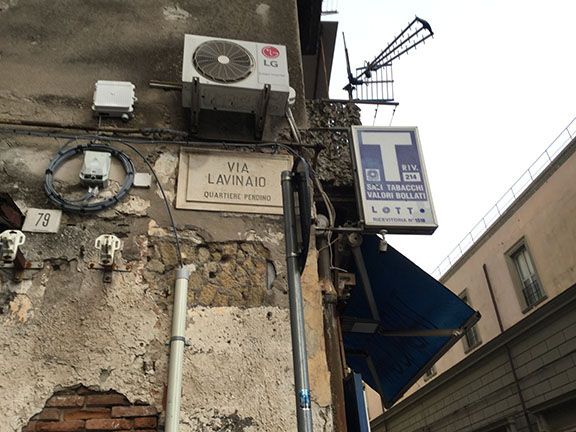
Day 4: Monday, 22 Ottobre 2018.
Napoli, Campania, La Marinella neighborhood.
We are in Napoli, and, ragazzi (guys), the apartment is fabulous! Huge rooms, good location and look at this rainbow, which appeared outside the north-facing balcony of the apartment within minutes of our arrival. I choose to believe my (long dead) grandfather Domenic Troisi delivered this to welcome us to his hometown. The train from Rome was easy, convenient, comfortable and really fast (150 miles/hour we estimated.) I will post directions for the train later to help other family members who are coming from Rome next week.
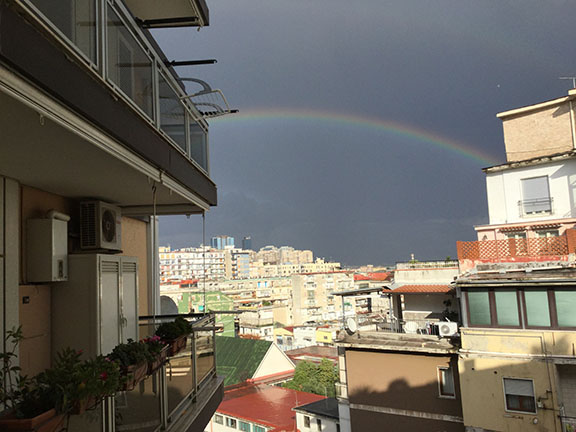
Day 3: Sunday, 21 Ottobre 2018.
Roma, Lazio.
This is my new best friend Barbara Tintisona.
I hired her to do some research for me in Rome (highly recommended, inquire for details) and met her on Sunday. We were together for 3 hours, and I’m pretty certain we talked for 2 hrs and 59 minutes of the time.
After coffee, she says, what are you plans today, may I show you my favorite Roman attraction? Me: sure!
We get in the car and drive a bit, then up a big hill that has 4 churches on it. She says “oh the line’s not bad, you don’t mind a line, right?” I say “no,” because…non-stop talking who cares where we do it.
So we get in line in front of this building. Knights of Malta something or other. Line doesn’t move. Me: Are we waiting for it to open? Barbara: Sort of, but I don’t want to tell you, you will be surprised.

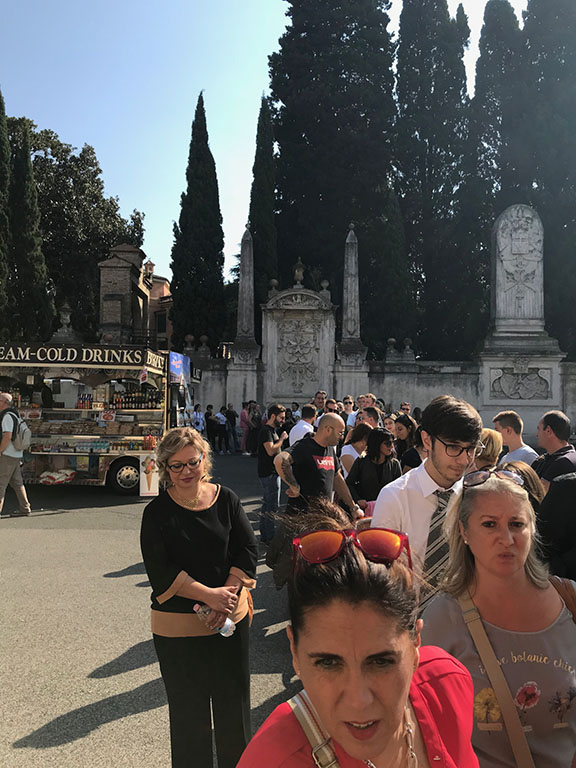
More yacking. Line moves slowly but doors don’t actually open. What is this?
Front of line: people patiently and graciously take turns peeping through a keyhole in a door.
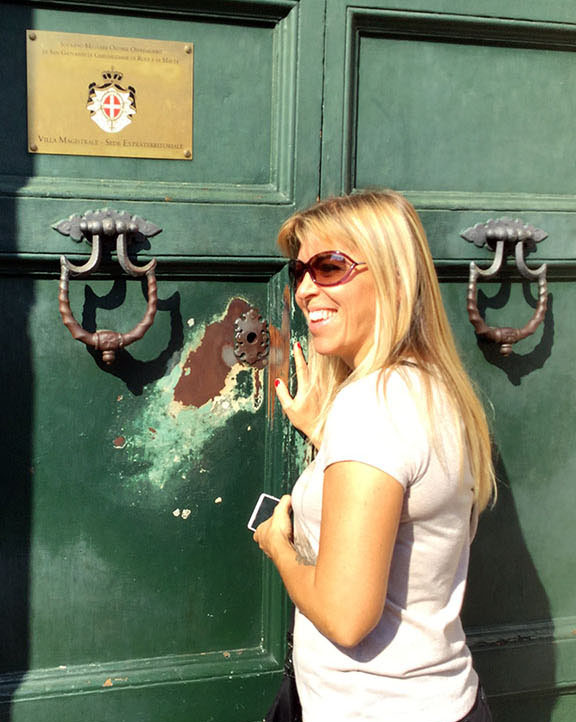
My first thought, of course, is gutter-worthy: Is it like the Duchamp “sculpture” at the Philadelphia Museum of Art? (Start Googling, people.) Nah, people walking away don’t look alarmed, and 4 churches….
I will tell you the name of the site and the first person to post the correct reply wins lunch on me and a souvenir from Italy (of my choosing, well maybe I’ll take suggestions).
The Aventine Keyhole.
Go!
Are you not in love with this woman now, too? (Thank you, Fred Gardaphe, for the introduction to Barbara!)
]]>Day 2: Saturday, 20 Ottobre 2018.
Roma, Lazio.
These pines and cypresses say Italy to me, as in “I’m not in Kansas anymore.” Today I learned that they are called pini Mediterraneo—Mediterranean pines. They are some kind of conifer that grows only close to the sea within the range that the wind blows its seeds or something. I call them the broccoli trees because of the way the canopies sit high on the stalks after many years. These are along the Via dei Fori Imperiali and are well known as part of the landscape wherever there are ancient ruins in Rome. And that’s the end of what Janice knows about nature.
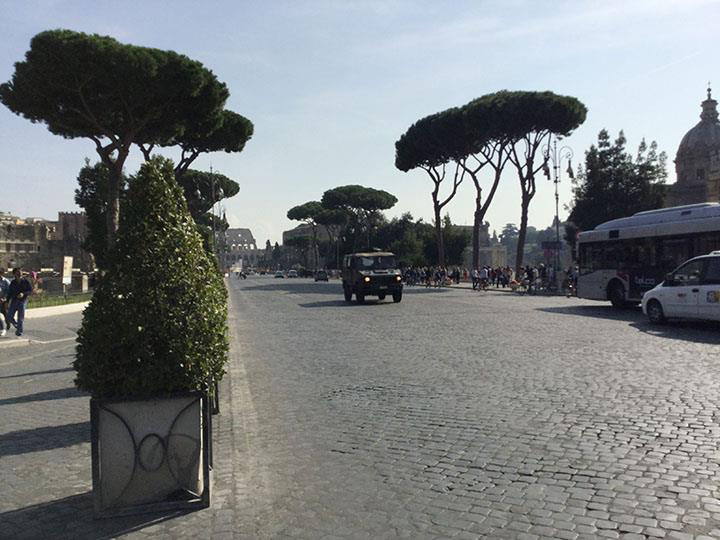
Day 2: Saturday, 20 Ottobre 2018.
Roma, Lazio.
I was in Rome once before, in 1983, and I almost cried when I got to the Trajan Column, because it was covered in scaffolding. But I saw it today, and I have forgiven the Italians for denying it to me in the past, because they have done a spectacular restoration of the ancient Roman center of the city, including the column.
Mussolini famously put a road through the center of the area so he could have tank parades or something. The road is still there, but it now cobble-stoned and is closed to all but city buses and military jeeps, apparently, per my photo today. (Rumor is pedestrians take it over during peak touring season.) Squint at the second photo and you can see the Coliseum at the end of the vista. Also, a substantial area of additional ruins on the east side of the road has been excavated and revealed.
Well done, Italy!
My interest in the Trajan Column is as a graphic designer. Most people look at the picture story of Emperor Trajan’s military victories, but graphic designers trek to this Valhalla for a glimpse of the tiny (really, quite small) plaque on the south side which has some inscription about Trajan and is considered the best, BEST example of Roman lettering ever anywhere, i.e. the basis of our alphabet. I was there at the wrong time of day to get good sunlight on the inscription so enjoy these photos (and good story) instead:
http://codex99.com/typography/21.html
If any of you have ever experimented with using “classic serif fonts,” you now know the origin of the one named Trajan!

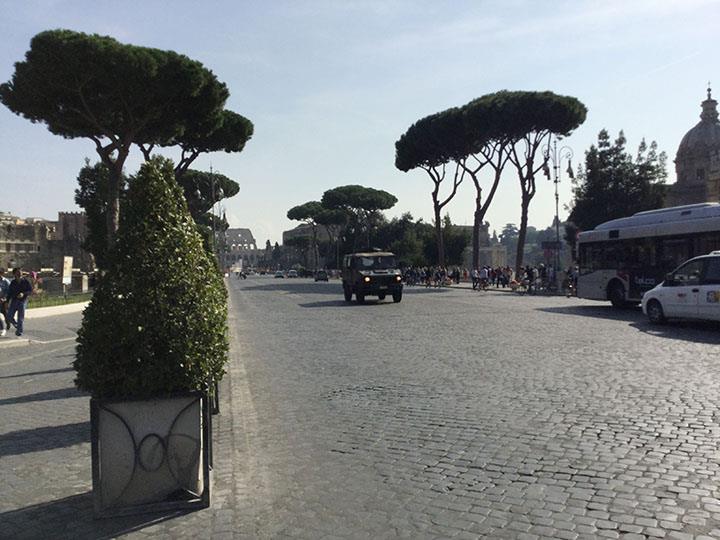
New York, USA, 13 Ottobre 2018.
Our family has a street in Naples!
In advance of our trip, I am communicating with this lovely man, Alfonso Buongiorno, who owns a leather tanning business in Solofra. (https://www.facebook.com/profile.php?id=100015900452619)
He thinks he is related to us like this: Biagio Buongiorno, father of our Great-grandmother Maria Michela Buongiorno Troisi and of artist Donato/Donatus Buongiorno, was a brother of his Great-great-grandfather Michele Buongiorno. (Update Nov 18: Later, when meeting him in person, Alfonso said there were two male cousins with the names of the ancestors we know, which means the ancestor in common is those two mens’ grandfather. This might be a translation issue. I will sort it out based on comprehensive documents Alfonso gave me, and will post definitive information later.)
He will meet us in Solofra on Nov. 1 and show us his family history book with his family tree!
He reports that the Buongiornos have been tanners and goldsmiths (not of jewelry, I learned later: gold leafing of leather and other interior furnishings, such as columns, capitals, walls) in Solofra for centuries, and that some of them went to Naples during each generation to facilitate trade. (Residency was required to get a license for trade, I learned later.)
In Naples, still today, there is a Vicolo Buongiorno, which dates from the time when goldsmith Buongiornos were on the street. (Vicolo, also Vico, means alley.)
Guess what. It’s only a few blocks from Via Cesare Rosaroll where Domenic Troisi and his family lived in 1907 right before they migrated to the U.S.
The plot thickens….
Check it out on Google Earth and see how glamorous Vicolo Buongiorno is today. https://www.google.com/maps/place/Vico+Buongiorno,+80137+Napoli+NA,+Italy/@40.8560405,14.2553281,19z/data=!4m5!3m4!1s0x133b086941cb0da9:0xdec1e3b3eece833c!8m2!3d40.8560405!4d14.2558753
We come from class, people!
